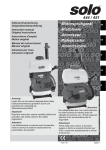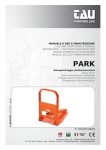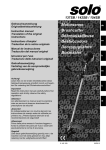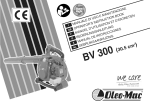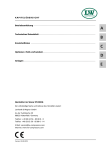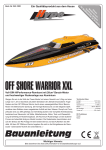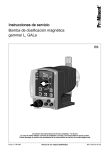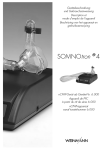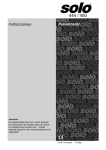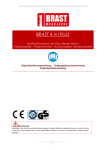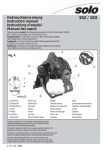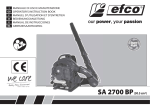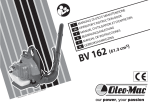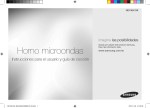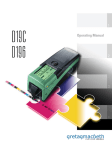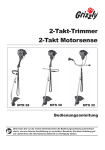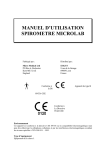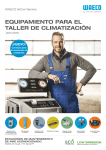Download Gebrauchsanweisung Instruction manual Instructions d
Transcript
471/472 Gebrauchsanweisung Instruction manual Instructions d'emploi Manual de instrucciones Istruzioni per l'uso Blasgerät Blower Unit Balai Souffleur Soplador Soffiatore Achtung! Lesen Sie vor der ersten Inbetriebnahme diese Gebrauchsanweisung gründlich durch und beachten Sie unbedingt die Sicherheitsvorschriften! Important! Read this instruction manual carefully before first operation and strictly observe the safety regulations! Attention! Lire attentivement ce manuel avant la première mise en service et observer absolument les prescriptions de sécurité! ¡Atención! Es indispensable leer con mucha atención las instrucciones de manejo antes de utilizarla por primera vez. ¡Preste especial atención a las recomendaciones de seguridad! Attenzione! Prima della prima messa in funzione leggere a fondo le presenti istruzioni per l'uso e osservare assolutamente le norme di sicurezza. 9 471 102 01/2005 Vorwort Symbole Verehrte Kundin, lieber Kunde Vielen Dank, dass Sie sich für dieses SOLO Qualitätsprodukt entschieden haben. Ein Einzylinder-Zweitakt-Motor mit nikasilbeschichtetem Zylinder in bewährter SOLOTechnik für hohe Leistung und niedrigen Kraftstoffverbrauch garantiert einen hohen Gebrauchswert der Maschine. Lesen Sie vor der ersten Inbetriebnahme diese Gebrauchsanweisung gründlich durch und beachten Sie vor allen Dingen die Sicherheitsvorschriften. Um die Leistungsfähigkeit Ihres SOLO Blasgerätes über eine lange Zeit zu erhalten, sollten Sie die Wartungsanweisung genau einhalten. Sollten Sie nach dem Studium dieser Gebrauchsanweisung noch weitergehende Fragen haben, steht Ihnen Ihr SOLO-Händler gerne zur Verfügung. Folgende Symbole werden am Gerät und in dieser Gebrauchsanweisung verwendet: Vor Inbetriebnahme und vor allen Wartungs-, Montage- und Reinigungsarbeiten Gebrauchsanweisung gründlich lesen Seien Sie beim Umgang mit dem Motorgerät besonders vorsichtig Verboten! Vor dem Starten des Motors Gehörschutz und Gesichtsschutz aufsetzen In der Nähe des Motorgeräts und dem Ort des Tankens ist Rauchen verboten! Das Motorgerät und die KraftstoffNachfüllbehälter von offenem Feuer fernhalten Motor starten Motor ausschalten Beim Arbeiten mit und an dem Gerät Schutzhandschuhe tragen Kraftstoffgemisch CE Konformitätserklärung entsprechend der EG-Richtlinie 98/37/EG, 2000/14/EG und 89/336/EWG (geändert durch 92/31/EWG). Die SOLO Kleinmotoren GmbH, Stuttgarter Straße 41, D-71069 Sindelfingen erklärt in alleiniger Verantwortung, dass dieses Produkt, auf das sich diese Erklärung bezieht, den Bestimmungen der Maschinenrichtlinie entspricht. Produktbezeichnung: Serien-/ Typenbezeichnung: Schallleistungspegel (DIN45635) garantiert gemessen 101,5 101,0 dB(A) dB(A) Diese Konformitätserklärung verliert ihre Gültigkeit, wenn das Produkt ohne Zustimmung umgebaut oder verändert wird. Sindelfingen, den 01. Januar 2005 SOLO Kleinmotoren GmbH DEUTSCH 2 Chokeklappe geschlossen, Kaltstarteinstellung Verschleißteile Gartenbläser 471 472 96,5 96,0 Chokeklappe geöffnet Arbeitsstellung Wolfgang Emmerich Geschäftsführer Verschiedene Bauteile unterliegen gebrauchsbedingtem Verschleiß bzw. einer normalen Abnutzung und müssen ggf. rechtzeitig ersetzt werden. Nachstehende Verschleißteile unterliegen nicht der Herstellergarantie: x Luftfilter x Kraftstofffilter x alle mit Kraftstoff und Spritzmittel in Berührung kommenden Gummiteile x Zündkerze x Startvorrichtung Inhaltsverzeichnis 1. 2. 3. 4. 5. 6. 7. 8. 9. Seite Wichtige Bauteile ...................................................................................................................... 4 Sicherheitsvorschriften ............................................................................................................. 5 2.1 Allgemeine Sicherheitshinweise 5 2.2 Persönliche Schutzausrüstung für Ihre Sicherheit 5 2.3 Umweltschutz 5 2.4 Arbeitshinweise 5 Wartung und Pflege .................................................................................................................. 6 3.1 Allgemeine Wartungshinweise 6 3.2 Kraftstoff-Information 6 3.3 Zündkerze 7 3.4 Stillegen und Aufbewahren 7 3.5 Vergasereinstellung 7 3.6 Luftfilter Wartung 8 Zusammenbau ........................................................................................................................... 9 4.1 Faltschlauch montieren 9 4.2 Gasgriff und Blasrohr montieren 9 Motor starten / Motor abstellen............................................................................................. 10 Arbeitshinweise....................................................................................................................... 11 6.1 Einstellen der Tragegurte 11 Wartungsplan........................................................................................................................... 12 Technische Daten ..................................................................................................................... 13 Zubehör .................................................................................................................................... 13 Garantie Der Hersteller garantiert eine einwandfreie Qualität und übernimmt die Kosten für eine Nachbesserung durch Auswechseln der schadhaften Teile im Falle von Material- oder Herstellungsfehlern, die innerhalb der Garantiezeit nach dem Verkaufstag auftreten. Bitte beachten Sie, dass in einigen Ländern spezifische Garantiebedingungen gültig sind. Fragen Sie im Zweifelsfall Ihren Verkäufer. Er ist als Verkäufer des Produktes für die Garantie verantwortlich. Wir bitten um Ihr Verständnis, dass für folgende Schadensursachen keine Garantie übernommen werden kann: x Nichtbeachtung der Gebrauchsanweisung. x Unterlassung von notwendigen Wartungs- und Reinigungsarbeiten. x Schäden auf Grund unsachgemäßer Vergasereinstellung. x Verschleiß durch normale Abnutzung. x Offensichtliche Überlastung durch anhaltende Überschreitung der Leistungsobergrenze. x Verwendung nicht zugelassener Arbeitswerkzeuge. x Gewaltanwendung, unsachgemäße Behandlung, Missbrauch oder Unglücksfall. x Überhitzungsschaden auf Grund von Verschmutzungen am Ventilatorgehäuse. x Eingriffe nicht sachkundiger Personen oder unsachgemäße Instandsetzungsversuche. x Verwendung ungeeigneter Ersatzteile bzw. nicht Originalteile, soweit diese den Schaden verursachten. x Verwendung ungeeigneter oder überlagerter Betriebsstoffe. x Schäden, die auf Einsatzbedingungen aus dem Vermietgeschäft zurückzuführen sind. Reinigungs-, Pflege- und Einstellarbeiten werden nicht als Garantieleistung anerkannt. Jegliche Garantiearbeiten sind von dem vom Hersteller autorisierten Fachhändler auszuführen. DEUTSCH 3 Wichtige Bauteile 1. Wichtige Bauteile Fig. 1 1. 2. 3. 4. 5. 6. 7. 8. 9. 10. Kurzschluß-Schalter Gashebel Stellhebel Primer Chokehebel Luftfilter-Abdeckung Kraftstofftank-Deckel Startergriff Zündkerze Auspuff DEUTSCH 4 11. 12. 13. 14. 15. 16. 17. 18. 19. 20. Vergaser-Einstellschrauben Vibrations-Dämpfungsfedern Klickverschluß Tragegurt Tragegurt Tragegestell Faltenschlauch Blasrohr 1 Verlängerungsrohr 2 Krümmerdüse Gebläsegehäuse Wichtige Bauteile; Sicherheitsvorschriften 21. Verschlussstopfen (Hinweis: Beim Umbau zum Sprühgerät erfolgt hier der Anschluss zum Brühebehälter) 2. Sicherheitsvorschriften 2.1 Allgemeine Sicherheitshinweise Aus Versandgründen wird das Blasgerät teilweise zerlegt ausgeliefert und muss vor Erstinbetriebnahme komplettiert werden (Fig. 4/5). Das Blasgerät darf nur in komplett zusammengebautem Zustand in Betrieb genommen werden. Lesen Sie diese Gebrauchsanweisung vor der ersten Inbetriebnahme aufmerksam durch und bewahren Sie sie sicher auf. Erstbenutzer sollten sich vom Verkäufer oder durch einen Fachmann einweisen lassen. Die Bedienungsperson ist im Arbeitsbereich des Blasgerätes Dritten gegenüber verantwortlich. Nur in guter körperlicher Verfassung arbeiten. Auch Ermüdung oder Krankheit führt zu Unachtsamkeit. Alle Arbeiten ruhig und umsichtig durchführen. Niemals unter Einfluss von Alkohol oder Drogen arbeiten. Der Luftstrahl hat eine sehr hohe Austrittsgeschwindigkeit und darf daher niemals auf Personen und Tiere gerichtet werden. 2.2 Persönliche Schutzausrüstung für Ihre Sicherheit Um Verletzungen von Kopf, Augen, Hand, Fuß sowie Gehörschäden zu vermeiden, muss die nachfolgend beschriebene Schutzausrüstung getragen werden: Die Kleidung soll zweckmäßig, d.h. eng anliegend, aber nicht hinderlich sein. Keinen Arbeitsmantel, kurze Hosen, Sandalen sowie keinen Schal, Krawatte, Schmuck usw. tragen, die ein Verfangen an Buschwerk oder Ästen ermöglichen. Schützen Sie Ihr Gesicht und Ihre Augen mit einem Gesichtsschutz oder einer Schutzbrille. Zur Vermeidung von Gehörschäden sind geeignete persönliche Schallschutzmittel zu tragen (wie z.B. Gehörschutz, Kapseln, Wachswatte etc.). Tragen Sie kräftiges Schuhwerk mit rutschfester Sohle. Die Unfall-Verhütungsvorschriften der zuständigen Berufsgenossenschaften sind zu beachten. Anwendungshinweise x x x Während der Arbeit sind die Sicherheitshinweise unbedingt zu beachten. Das Blasgerät ermöglicht die Beseitigung von Laub, Gras, Papier, Staub oder Schnee, z.B. in Gartenanlagen, Sportstadien, Parkplätzen oder Einfahrten. Es ist auch geeignet zum Trockenen von PKW und zum Freiblasen von Laub und kleinen Zweigen z.B. bei der Steinobst-Ernte. Das Blasgerät nur für die dafür vorgesehenen Arbeiten nutzen - für keine anderen! 2.3 Umweltschutz Achten Sie auf Ihre Umwelt x x Achten Sie auf Tiere, die sich im Arbeitsbereich aufhalten können! Bedenken Sie, dass auch Lärm eine Belästigung für die Umwelt bringt. Halten Sie sich ggfs. an Ruhezeiten, die örtlich verschieden sein können! 2.4 Arbeitshinweise x x x x x Gehen Sie im Leerlauf an das Blasgut heran und geben Sie dann Vollgas. Im Umkreis von 15 m dürfen sich keine weiteren Personen aufhalten. Besonders auf Kinder und Tiere achten. Vom Luftstrahl mitgerissene Partikel können an Hindernissen abprallen und umstehende Personen gefährden. Nie auf instabilen Untergründen arbeiten. Wegen erhöhter Stolpergefahr auf Hindernisse wie Baumstümpfe, Wurzeln, Gräben u. dgl. achten. Besondere Vorsicht beim Arbeiten an Hängen. Niemals den heißen Auspuff berühren. DEUTSCH 5 Wartung und Pflege 3. Wartung und Pflege 3.1 Allgemeine Wartungshinweise Nach einer Einlaufzeit von ca. 5 Betriebsstunden müssen alle erreichbaren Schrauben und Muttern (ausgenommen den Vergaser-Einstellschrauben) auf Festsitz überprüft und evtl. nachgezogen werden. x Reinigungs- Wartungs- und Reparaturarbeiten nur bei abgestelltem Motor durchführen Zündkerzenstecker abziehen. Ausnahmen: Leerlauf- und Vergasereinstellung. Verhalten bei der Wartung x Andere Wartungsarbeiten, als die in dieser Gebrauchsanweisung beschriebenen, dürfen nur von einer autorisierten SOLO Fachwerkstatt vorgenommen werden. Dabei dürfen nur Original-Ersatzteile verwendet werden. x Keine Änderung am Motor-Sprühgerät vornehmen - Ihre eigene Sicherheit ist dadurch gefährdet. x Keine Wartung und Aufbewahrung in der Nähe von offenem Feuer. x Regelmäßig den Tankverschluss auf Dichtheit/Belüftung überprüfen. Einwandfreie Zündkerzen verwenden. Zündkabel auf Beschädigung überprüfen. x Das Blasgerät nicht mit defektem oder demontiertem Schalldämpfer betreiben (Brandgefahr, Gehörschäden). Heiße Schalldämpfer nicht berühren. Beim Transport im Kfz ist auf gesicherten Stand des Gerätes besonders zu achten, damit kein Kraftstoffauslaufen kann. x Bei längerer Lagerung und beim Versand des Blasgerätes muss der Kraftstofftank vollständig entleert sein. 3.2 Kraftstoff-Information Kraftstoff und Öl Kraftstoff: Der Motor Ihres Motor-Blasgerätes ist ein Hochleistungs-Zweitaktmotor und muss mit einer Kraftstoff-Öl-Mischung oder mit im Fachhandel erhältlichen vorgemischten SonderKraftstoffen für 2-Takt-Motore betrieben werden. Wichtig: Im Kraftstoff-Gemisch kann bleifreies Normalbenzin, bleifreies Euro-Benzin, oder bleifreies Super-Benzin verwendet werden (MindestOktanzahl 92 ROZ). Mischungsverhältnis: Wir empfehlen ein Mischungsverhältnis KraftstoffÖl von 50:1(2%) bei Verwendung des von uns angebotenen Spezial-2-Takt-Öls "Castrol Super TT". Bei Verwendung von anderen Marken-Zweitaktölen empfehlen wir ein Mischungsverhältnis von 25:1(4%). Hinweis: Bevorraten Sie die Mischung nicht länger als 3-4 Wochen. Kraftstoff-Mix-Tabelle Benzin in Liter Öl in Liter Castrol Super TT 2% (50 : 1) Anderes Zweitakt-Öl 4% (25 : 1) 1 0,020 0,040 5 0,100 0,200 10 0,200 0,400 Einlaufvorschrift: Für die ersten fünf Tankfüllungen auch bei SpezialZweitaktöl ein Mischungsverhältnis 25:1 (4%) verwenden! x Rauchen und jedes offene Feuer ist nicht zulässig. x Vor dem Tanken die Maschine abkühlen lassen. x Kraftstoffe können lösungsmittelähnliche Substanzen enthalten. Haut- und Augenkontakt mit Mineralölprodukten vermeiden. Beim Betanken Handschuhe tragen. Schutzkleidung öfter wechseln und reinigen. Kraftstoffdämpfe nicht einatmen. x Kein Kraftstoff oder Öl verschütten. Wenn Kraftstoff oder Öl verschüttet wurde, MotorSprühgerät sofort säubern. Kraftstoff nicht mit Kleidung in Berührung bringen. Falls Kraftstoff an die Kleidung gelangt, Kleidung sofort wechseln. x Darauf achten, daß kein Kraftstoff oder Öl ins Erdreich gelangt (Umweltschutz). Geeignete Unterlage verwenden. x Nicht in geschlossenen Räumen tanken. Kraftstoffdämpfe sammeln sich am Boden (Explosionsgefahr). x Kraftstoff und Öl nur in zugelassenen und gekennzeichneten Kanistern transportieren und lagern. Kraftstoff und Öl Kindern nicht zugänglich machen. x Achten Sie bei der Arbeit darauf, dass Sie die Abgase des Motors nicht einatmen. Benutzen des Blasgerätes in geschlossenen Räumen ist verboten. Der Umgang mit Kraftstoffen erfordert vorsichtige und umsichtige Handlungsweise. Unbedingt Sicherheitshinweise beachten! x Tanken Sie nur bei ausgeschaltetem Motor! x Umgebung der Einfüllbereiche gut säubern. DEUTSCH 6 Wartung und Pflege x Tankverschluss abschrauben und Kraftstoffgemisch nur bis zur Unterkante des Einfüllstutzens einfüllen. Nicht überfüllen und nach Möglichkeit einen Siebtrichter verwenden. x Vorsichtig einfüllen, um kein Kraftstoffgemisch oder Öl zu verschütten. x Tankverschluss wieder fest aufschrauben. 3.3 Zündkerze Die Regulierschrauben für Leerlaufgemisch "L" und Volllastgemisch "H" dürfen nur von der autorisierten Fachwerkstatt eingestellt werden. Geringfügige Einstellungskorrekturen des Standgases auf die in den technischen Daten angegebene mittlere Leerlaufdrehzahl können über die Leerlauf-Anschlagschraube "T" mit Hilfe eines Drehzahlmessers wie folgt vorgenommen werden: x Wenn der Leerlauf zu hoch ist, drehen Sie die Leerlauf-Anschlagschraube "T" entgegen dem Uhrzeigersinn etwas auf. x Wenn der Leerlauf zu niedrig ist (der Motor also stehen bleibt), drehen Sie die LeerlaufAnschlagschraube "T" im Uhrzeigersinn etwas zu, bis der Motor gleichmäßig durchläuft. Die Zündkerze (Wärmewert 200) ist z.B. unter folgenden Bezeichnungen erhältlich: BOSCH CHAMPION WSR6F RCJ-6Y oder vergleichbar Der vorschriftsmäßige Elektrodenabstand beträgt 0,5 mm. Überprüfen Sie regelmäßig alle 50 Betriebsstunden die Zündkerze. Bei stark abgebrannten Elektroden muss sie ersetzt werden. 3.4 Stillegen und Aufbewahren Das Blasgerät ist in einem trockenen Raum für Kinder unzugänglich aufzubewahren und mit einem Schutz zu versehen. Eine besondere Motorkonservierung ist bei Verwendung des von uns angebotenen SpezialZweitakt-Öles "Castrol Super TT" nicht erforderlich. Bei längerem Aufbewahren Benzintank ganz entleeren. Sollte eine optimale Vergasereinstellung durch korrigieren der Leerlauf-Anschlagschraube "T" nicht erreicht werden, lassen Sie bitte den Vergaser durch eine autorisierte Fachwerkstatt optimal einstellen. Die nachfolgenden Anweisungen sind für die autorisierte Fachwerkstatt bestimmt Bei D-Cut-Vergasern: Zur Korrekturen an der LeerlaufGemischregulierschraube "L" und der VolllastGemischregulierschraube "H" ist der D-CUTVergaserschlüssel zu verwenden. Bei Vergasern mit Limitercaps: Die Regulierschrauben für Leerlaufgemisch und Volllastgemisch können nur in einem begrenzten Bereich verstellt werden. 3.5 Vergasereinstellung Der Vergaser wird im Werk optimal eingestellt. Je nach Einsatzort (Gebirge, Flachland) kann eine Korrektur der Vergasereinstellung erforderlich werden. Fig. 2 Zur korrekten Leerlaufeinstellung, muss der Luftfilter sauber sein! Lassen Sie vor der Einstellung den Motor warmlaufen. Die Vergasereinstellung dient zur Erzielung der maximalen Motorleistung. Zur Einstellung ist unbedingt ein Drehzahlmesser zu verwenden! Keine höhere Drehzahl als angegeben einstellen, da dies zu Motorschäden führen kann! Der Vergaser hat 3 Einstellschrauben: x Leerlauf-Anschlagschraube "T" x Leerlauf-Gemischregulierschraube "L" x Volllast- Gemischregulierschraube "H" DEUTSCH 7 Wartung und Pflege 3.6 Luftfilter Wartung Der Luftfilter hält den mit der Verbrennungsluft angesaugten Schmutz zurück und vermindert damit den Verschleiß des Motors. Fig. 3 Eine regelmäßige Wartung verlängert die Lebensdauer Ihres Gerätes. Verschmutzte Luftfilter haben eine Leistungsminderung des Motors zur Folge. Sie erhöhen den Kraftstoffverbrauch und somit die Schadstoffe im Abgas. Außerdem wird das Starten erschwert. Bei ganztägigem Einsatz muss der Luftfilter täglich gereinigt werden. Bei größerem Staubanfall auch zwischendurch. Einfaches Ausklopfen ist zur Reinigung am besten geeignet. Luftfilter nicht mit Druckluft ausblasen und niemals feucht oder nass reinigen, und nicht in Ölbad bzw. Reinigungslösung einlegen! Sollte bei korrekter Vergasereinstellung die Motordrehzahl deutlich absinken, ist der Luftfilter verstopft und muss ausgetauscht werden (Bestell-Nr. 20 48 280). Eine durch einen verstopften Luftfilter resultierende zu niedrige Motordrehzahl darf auf keinen Fall über eine unkorrekte Vergasereinstellung ausgeglichen werden. Dies würde zur Überlastung und schwerwiegende Motorschäden führen. Für Motorschäden, die durch unsachgemäße Pflege entstehen, kann kein Garantieanspruch abgeleitet werden. Zum Ausbau des Luftfilters, Luftfilterabdeckung abnehmen. Filterdeckel-Schraube lösen (Fig. 1. Pos 8). DEUTSCH 8 Zusammenbau 4. Zusammenbau Vor der ersten Inbetriebnahme muss das Gerät komplettiert werden: 4.1 Faltschlauch montieren Fig. 4 Die Schrauben A und B entfernen. Faltenschlauch (16) bis zum fühlbaren Widerstand in die Öffnung vom Gebläsegehäuse (20) stecken und beidseitig mit den Schrauben A und B wieder fixieren. Hinweis: Auf leichte Drehbeweglichkeit des Faltenschlauches ist zu achten. 4.2 Gasgriff und Blasrohr montieren Fig. 5 Gasgriff auf das Blasrohr I stecken und auf der gewünschten Position mit 2 Schrauben festschrauben. Die Verstellmöglichkeit entsprechend der Armlänge beträgt ca. 50 mm. Blasrohr in den Faltenschlauch (1.16) stecken und mit Kunststoffschelle (C) befestigen. Hinweis: Über den Handgriff lässt sich das Blasrohr im Faltenschlauch schwenken/drehen. Darauf achten, dass dabei keine Kabelverbindungen gelöst werden. • Verlängerungsrohr II im Blasrohr I einsetzen und durch Drehen mittels Bajonettverschluss befestigen. • Krümmerdüse auf Verlängerungsrohr stecken und mit Bajonettverschluss fixieren. DEUTSCH 9 Motor starten / Motor abstellen 5. Motor starten / Motor abstellen Starten bei kaltem Motor Fig. 6 durchziehen, bis das Gerät hörbar kurzzeitig anspringt (zündet). x Dann sofort Choke-Hebel (7.1) wieder in Ausgangsposition bringen! "Chokeklappe und weiter starten. öffnen" x Wenn der Motor läuft, zur Drehzahlbeschleunigung den Gashebel (6.2) betätigen, bzw. die gewünschte Gasstellung für Dauerbetrieb mit dem Stellhebel (6.3) wählen. x Zum Standgasbetrieb Gashebel loslassen, bzw. Stellhebel in Ausgangsposition "min" nach unten bringen. Starten bei betriebswarmem Motor bzw. nach kurzzeitigem Abstellen. x Chokeklappe geöffnet lassen und Motor starten. Sollte der Motor trotz weiterer Startversuche nicht anspringen, ist der Brennraum bereits überfettet. x Kurzschluss-Schalter (6.1) auf Betriebsposition "I" bringen und Abstellhahn schließen (OFF). x Stellhebel(6.3) in "min"-Position bringen (Motor wird im Leerlauf gestartet). Fig. 7 In diesem Fall empfiehlt es sich, die Zündkerze (1.9) auszuschrauben und abzutrocknen. Stellen Sie den Kurzschlussschalter (6.1) auf "Stop" und den Stellhebel (6.3) auf Vollgasstellung "max" und ziehen Sie den Startergriff bei aufgeschraubter Zündkerze zur Belüftung des Brennraums mehrmals durch. Anschließend Zündkerze wieder einschrauben und den Vorgang des Startens wiederholen. Abstellen des Motors x Gashebel oder Stellhebel auf Standgasposition bzw. "min"-Position bringen. x Den Kurzschluss-Schalter in "Stop"-Stellung bringen, bis der Motor stehen bleibt. x Mit Choke-Hebel (7.1) Chokeklappe schließen. x Den Primer mehrmals drücken, bis im Kunststoffballon Kraftstoff sichtbar ist. x Das Gerät mit der linken Hand am Tragegriff (1.15) festhalten. Mit der rechten Hand den Startergriff (1.8) langsam bis zum ersten Widerstand heraus- und dann schnell und kräftig DEUTSCH 10 Arbeitshinweise 6. Arbeitshinweise Vor jedem Arbeitsbeginn und vor jedem Startvorgang das Blasgerät auf einwandfreie Funktion und vorschriftsmäßigen Zustand überprüfen (Gasbetätigung, Kurzschlussschalter, Schutzvorrichtung, Tragegurt, und KraftstoffLeckstellen untersuchen). x Vor dem Starten und während dem Arbeiten muss die Bedienungsperson einen sicheren Stand und eine sichere Körperstellung einnehmen. x Zum Starten des Blasgeräts den Standort wechseln, mindestens 3 m vom Ort des Tankens. 6.1 Einstellen der Tragegurte Fig. 8 Blasgerät auf den Rücken nehmen und Tragegurte beidseitig im Klickverschluss (1.13) einrasten. Die Schultergurte sind mit Hilfe von Klemmschiebern auf die erforderliche Länge einstellbar. Durch Herunterziehen der beiden Gurtenden werden die Tragegurte gestrafft. (a) Durch Anheben der beiden Klemmschieber werden die Tragegurte wieder gelöst. (b) Hinweis: Die Tragegurte sind so einzustellen, dass die Rückenplatte fest und sicher am Rücken der Bedienungsperson anliegt. DEUTSCH 11 Vergaser Leerlauf kontrollieren X X reinigen X X ersetzen Zündkerze vor Spritzsaison X Leerlauf einstellen Luftfilter bei Bedarf nach 50 Betriebsstunden wöchentlich täglich Die folgenden Hinweise beziehen sich auf normale Einsatzverhältnisse. Bei besonderen Bedingungen, wie z.B. besonders langer, täglicher Arbeitszeit, müssen die angegeben Wartungsintervalle entsprechend verkürzt werden. jeweils vor Arbeitsbeginn 7. Wartungsplan einmalig nach 5 Betriebstunden Wartungsplan X Elektronenabstand prüfen und ggf. nachstellen X X ersetzen Kühlluft- Gebläseluft-Einlass reinigen X X X Zylinderrippen reinigen X X Kraftstofftank reinigen alle erreichbaren Schrauben (außer Einstellschrauben) nachziehen Bedienungsgriff Funktionsprüfung X Gesamte Maschine Sicht- Zustandsprüfung X X X reinigen X X X X X Führen Sie die Wartungsarbeiten regelmäßig durch. Beauftragen Sie eventuell eine Fachwerkstatt, wenn Sie nicht alle Arbeiten selber durchführen können. Der Gerätebesitzer ist auch verantwortlich für: x Schäden durch nicht fachmännisch bzw. rechtzeitig durchgeführte Wartungs- oder Reparaturarbeiten x Folgeschäden - auch Korrosion - bei unsachgemäßer Lagerung DEUTSCH 12 Technische Daten; Zubehör 8. Technische Daten Blasgerät 471 472 Motor SOLO Einzylinder-Zweitaktmotor Hubraum cm3 53 Bohrung / Hub mm 42 / 38 Kraftstofftank-Inhalt l 1,9 Kraftstoff-Mischungsverhältnis: 1:25 (4%) 1:50 (2%) mit "CASTROL SUPER TT" mit anderen Zweitaktölen Vergaser Lageunabhängiger Membranvergaser mit Primer und integrierter Kraftstoffpumpe Luftfilter Papierluftfilter Zündung Elektronisch gesteuerte Magnetzündung, verschleißfrei m3/h 950 1400 Luftgeschwindigkeit m/s 66 83 Mittlere Leerlaufdrehzahl 1 /min Max. zulässige Höchstdrehzahl 1 /min Maximale Gebläseleistung Arbeitsplatzbezogener Emissionswert LPeq nach EN ISO 11200; dB(A) Schalleistungspegel LWeq nach EN ISO 3744 gemessen / garantiert 95% dB(A) Gewichteter Mittelwert der Beschleunigung nach ISO 7916 rechter Handgriff bei Höchstdrehzahl Gewicht (betriebsfertig ohne Tankinhalt) Abmessungen ohne Blasrohr m/s2 2200 4600 5700 86 89 96 / 96,5 101 / 101,5 < 1,3 < 1,5 kg 9,3 mm Höhe: 485 / Breite: 550 / Tiefe: 280 9. Zubehör Neu: Für die aktuellen Modelle 471 und 472 wird ein kompletter Umbausatz angeboten, mit dem das Blasgerät zu einem vollwertigen Sprühgerät (entsprechend dem SOLO Qualitätssprühgerät 450) für den Pflanzenschutz umgerüstet werden kann: Umrüstsatz zum Sprühgerät SOLO Bestell-Nr.: 49 00 567 Im Interesse der ständigen Weiterentwicklung unserer Geräte müssen wir uns Änderungen des Lieferumfangs in Form, Technik und Ausstattung vorbehalten. Wir bitten auch um Verständnis, dass aus Angaben und Abbildungen dieser Anleitung keine Ansprüche abgeleitet werden können. DEUTSCH 13 Preface Symbols Dear Customer, We congratulate you on your new SOLO Blower Unit and hope that you will be satisfied with this modern tool. A state-of-the-art single cylinder two-cycle engine with Nikasil coated cylinder bore combined with renowned SOLO technology of high performance with low fuel consumption will guarantee a high degree of application value of this product. Read this operating manual carefully before using the machine for the first time and at all times, strictly observe all safety rules. In order to maintain the longterm performance of the SOLO Blower it is necessary that the maintenance instructions be followed. Should you require any further information after carefully studying this manual, please contact your specialist SOLO Dealer. The following symbols are used in this manual and on the product: Thoroughly read these operating instructions before undertaking any maintenance, installation and cleaning steps Always handle this power tool with particular care Prohibited Wear eye and ear protection Do not smoke No open flame Starting of engine Switch off engine Wear protective gloves fuel mixture choke open CE Declaration of conformity In accordance with CE directives 98/37 EC, 2000/14/EG and 89/336/EWG (amended with 92/31/EWG), SOLO Kleinmotoren GmbH, Stuttgarter Strasse 41, D-71069 Sindelfingen, being solely responsible, states that the product referred to in this declaration complies with the requirements of the machinery guidelines. Sound power level (DIN45635) Guaranteed sound Actual sound 471 472 96,5 96,0 101,5 101,0 dB(A) dB(A) This declaration of conformity loses its validity, if the equipment is converted or modified without the manufacturer's consent. Sindelfingen, 1 January 2005 SOLO Kleinmotoren GmbH st ENGLISH 2 Wolfgang Emmerich Geschäftsführer choke closed Parts subject to wear and tear Various parts are subject to application-specific or normal wear and must be replaced in good time, when required. The following parts are subject to normal wear and are not covered by the manufacturer's guarantee: x Air filter x Fuel filter x All rubber parts which come into contact with fuel x Spark plug x Starter Index 1. 2. 3. 4. 5. 6. 7. 8. 9. Page Important Components............................................................................................................. 4 Safety regulations ..................................................................................................................... 5 2.1 General safety instructions 5 2.2 Personal protective equipment for your safety 5 2.3 Protection of Environment 5 2.4 Operating Hints 5 Maintenance and Care .............................................................................................................. 6 3.1 General Maintenance Hints 6 3.2 Fuel-Information 6 3.3 Spark Plug 7 3.4 Preparation for Storage 7 3.5 Carburettor adjustment 7 3.6 Air Filter Maintenance 8 Assembly .................................................................................................................................... 9 4.1 Installation of pleated elbow tube 9 4.2 Install multi-function handle and blower tube 9 Starting / Stopping the engine ............................................................................................... 10 Operating Hints........................................................................................................................ 11 6.1 Adjustment of shoulder straps 11 Maintenance Plan .................................................................................................................... 12 Technical Specifications .......................................................................................................... 13 Accessories ............................................................................................................................... 13 Guarantee The manufacturer guarantees trouble-free quality and will cover the cost of replacing parts which are found to be faulty in material or workmanship within the prescribed guarantee period after the date of purchase. Please note that specific guarantee conditions may vary from country to country. If in doubt, ask your equipment vendor. He is responsible for guarantee matters. We hope you will understand that we cannot be liable for damage resulting from the following causes: x Non-compliance with the operating instructions. x Neglecting essential maintenance and repair work. x Damage caused by incorrect carburettor adjustment. x Wear in normal use. x Obvious overload by continuously exceeding the maximum performance limit of the product. x Using non-authorised tools. x Use of force, incorrect treatment, misuse and accidents. x Damage from excessive heat due to dirt build-up around the cooling fan housing. x Attempted adjustments and repairs by unqualified persons. x Use of unsuitable spare parts or third party parts, if these are the cause of the defect. x Use of unsuitable or stale fuel. x Damage caused by using the product in the hire or rental industry. Normal cleaning, adjustments or maintenance work fall outside the guarantee provisions. A service centre authorised by the manufacturer must carry out all guarantee work. ENGLISH 3 Important Components 1. Important Components Fig. 1 1. 2. 3. 4. 5. 6. 7. 8. 9. 10. On/Off Switch Throttle Lever Speed Lever Primer Choke Lever Air Filter Cover Fuel Tank Lid Starter Handle Spark Plug Muffler ENGLISH 4 11. 12. 13. 14. 15. 16. 17. 18. 19. 20. Carburetor Adjustment Screws Vibration Absorbing Springs Quick-Release Carrying Strap Carrying Strap Carrying Frame Pleated Elbow Tube Blower Tube 1 Extension Tube 2 Curved Nozzle Tube Blower Housing Important Components; Safety regulations 21. Plug (Note: This is where, when converting the equipment into a sprayer, the liquid container is connected) 2. Safety regulations 2.1 General safety instructions For despatch purposes, the blower is supplied partially disassembled and has to be fully assembled prior to use. (illustration 4, 5) The blower may only be operated when fully assembled. Read the operating instructions carefully before placing in service and keep them in a safe place. First time users should be instructed by the seller or an expert. Within the scope of the units operating area, the operator is responsible for injuries to other persons. Operate the blower only when in good physical condition. Fatigue or ill health may lead to lack of attention and care. The machine should be operated in a calm and alert manner. Never operate the blower when under the the influence of alcohol or drugs. The air exit speed from the nozzle is very high. Never point the nozzle towards persons or animals. 2.2 Personal protective equipment for your safety To prevent injuries to head, eyes, hand, feet or damage to hearing, the following protective equipment should be worn: Clothing should be appropriate for the job, i.e. not too loose and not too tight to be hindering. Do not wear work coat, shorts or sandals. The operator should not wear a scarf, a necktie or jewelry which may get caught by branches. Protect your face and eyes with a face guard or safety glasses. To avoid damage to hearing, the operator should wear suitable personal noise protection such as ear muffs, ear plugs or similar. Wear firm work shoes with non-slip soles. Always observe accident prevention regulations issued by local trade organizations or workers compensation boards. Notes for General Use x x x Always observe all safety hints while using the machine. The blower unit is suitable for the removal of leaves, grass, paper, dust or snow in areas such as gardens or parks, sports facilities, parking areas or drives. The blower can also be used for the removal of leaves and small branches while harvesting stone fruit. The blower unit may only be used for the purpose it has been designed for– and no other! 2.3 Protection of Environment Be aware of your surroundings x x Watch out for animals which may be within your work area Be aware that noise is harmful to the environment. Inquire about and respect possible local rest periods. 2.4 Operating Hints x x x x x Approach blowing task with engine at idling speed, then accelerate to full throttle. No other persons should be present within a circle of 15 meters from the operator. Watch out for children and animals. Objects carried by the air stream can deflect and injure nearby persons. Never operate on unstable ground watch out for any obstacles such as tree stumps, tree roots, ditches etc.. Take special care while working along slopes. Never touch a hot exhaust. ENGLISH 5 Maintenance and Care 3. Maintenance and Care 3.1 General Maintenance Hints After a running in period of approx. 5 hours, all accessible screws and nuts (except for carburetor mixture adjustment needles) have to be checked and re-tightened if required. Any service jobs, other than those described in this manual, should only be carried out by an authorized service center. x Any cleaning, maintenance or repair jobs should only be performed when the engine is stopped and with removed spark plug cap. The exception, of course, is carburetor tuning Maintenance Guide Lines x Any service jobs, other than those described in this manual, should only be carried out by an authorized service center. Only original parts may be used for any maintenance and service work. x Never modify your motorized mistblower – your personal safety is at risk. x Never service or store the machine near an open flame. x Regularly check the fuel tank lid for sealing and tank ventilation. Only use recommended spark plugs. Check ignition cable for any damage. x Do not operate the blower with a broken or removed muffler. This can lead to fires and cause hearing damage. Do not touch hot muffler. For transport in a vehicle, ensure the mistblower is well secured to avoid fuel spillage. x Completely empty the fuel tank before extended storage or shipment. 3.2 Fuel-Information Petrol and Oil The engine of your motorized air blower is a high performance 2-cycle engine and has to be operated with a fuel/oil mix or with a special, pre-mixed fuel for 2-cycle engines available from specialized dealers. Important: For the fuel mixture, use lead-free regular (standard) petrol, lead-free Euro-petrol or lead-free Super (premium) petrol. The minimum octane rating is 92 ROZ. Mixing Ratio: We recommend a mixing ratio of 50 parts fuel to 1 part of oil (50:1 - 2%) with the use of special 2-cycle oil "Castrol Super TT". When using other 2-cycle oils we recommend a mixture ratio of 25:1 (4%). Note: Never store fuel mixture for longer than 3-4 weeks. ENGLISH 6 Fuel mixture table Petrol in litres Oil in litres Castrol Super TT 2% (50 : 1) Other twostroke oils 4% (25 : 1) 1 0,020 0,040 5 0,100 0,200 10 0,200 0,400 Running Instructions: For the first 5 tank fillings, also when using special 2-cycle oils, use a mixing ration of 25:1 (4%)! x Smoking or open flame is prohibited. x Allow engine to cool before re-fueling. x Fuel may contain solvent-like substances. Avoid skin and eye contact with mineral products. Wear gloves while refueling. Frequently change and clean protective clothing. Do not inhale fuel vapors. x Do not spill fuel or oil. In case of spillage, immediately wipe off mistblower. Do not allow fuel mix to contact clothing. If fuel mix is spilled on clothing, change clothing immediately x Ensure fuel or oil do not contaminate soil (environmental protection). Always use a suitable protective soil cover. x Do not re-fuel in unventilated rooms. Fuel vapors collect at ground level (danger of explosion). x Transport and store fuel and oil only in approved and clearly marked containers. Children should have no access to fuel or oil. x Take care not to inhale exhaust fumes. Do not operate the blower in closed areas. The handling of fuel requires caution and consideration. It is imperative that all safety instructions are observed! x Only refuel when the engine has been stopped! x Clean the area around filler inlet before refueling. x Remove tank lid and fill fuel mix up to the lower edge of the filler neck. Do not overfill. If possible, always use a fuel funnel with filter. x Replace and secure fuel tank lid. Maintenance and Care 3.3 Spark Plug x The correct spark plug with thermal range 200 is available under the following brands: If the idling speed is too high, turn the idling end-stop screw "T" anti-clockwise. x If the idling speed is too low (engine stops) turn the idling end-stop screw "T" clockwise until the engine runs smoothly. BOSCH CHAMPION WSR6F RCJ-6Y or similar The correct electrode gap is 0.5 mm. Check the plug after every 50 operating hours and replace if electrodes are worn. 3.4 Preparation for Storage The blower is to be stored in a dry area and should be protected with a cover. The storage area should be inaccessible to children. Treatment with special anti-corrosion oil is not required if the mistblower is normally used with ”Castrol Super TT” two-cycle oil in the fuel mixture. If the idling speed cannot be set correctly with the idling end-stop screw "T", request an authorised service centre to tune the carburettor. The following instructions are for authorised service shops D-CUT carburettors: Use the D-CUT carburettor key to adjust the idle mixture screw "L" and the full load mixture screw "H". Carburettors with limiter caps: The regulating screws for idle mixture and full load mixture can only be adjusted in a limited range. For extended storage, completely empty the fuel tank. Clean the air filter before adjusting the low speed screw! Let the engine run warm before adjusting the engine speed. 3.5 Carburettor adjustment The carburettor is tuned for optimum engine performance. Use a rev counter to tune the carburettor correctly! Do not adjust the engine to a higher speed. Excessive engine speed can lead to major engine damage! The carburettor has been adjusted optimally at the factory. Subject to the operational altitude (mountains or low lying areas), the carburettor may require readjustment.. Fig. 2 The carburettor has 3 adjusting screws: x Idling end-stop screw "T" x Low speed mixture screw "L" x High speed mixture screw "H" Only qualified mechanics must adjust the regulating screws for idle mixture "L" and full load mixture "H". Turn the idling end-stop screw "T" to adjust the idling speed in accordance with the details provided in the specification. Use an engine rev counter for this job. ENGLISH 7 Maintenance and Care 3.6 Air Filter Maintenance The air filter separates and retains dirt before the air reaches the combustion chamber. This reduces engine wear. Fig. 3 Regular maintenance increases engine life. Clogged air filters cause performance loss and increased fuel consumption. This leads to a higher toxin level in the exhaust gas and also makes starting more difficult. When the machine is used all day, the air filter should be cleaned daily. In severe dust conditions clean more often in between. For a simple cleaning procedure we recommend tapping the air filter. Never use a high pressure air cleaner nor wet or moist cleaning. Do not use solvent or oil bath cleaners! If engine rpm's tend to drop although the carburettor adjustments are perfectly set, the air filter cartridge is clogged and must be replaced by a new one (Order-Nr. 20 48 280). Never do realignments on the factory carburettor settings in order to balance a clogged air filter system. This procedure would cause engine damages due overload of the engine. Warranty claims cannot be accepted for damaged engine parts caused by improper care and maintenance For removal of the air filter, remove filter cover. Remove filter cover screw (Fig. 1 Pos. 8). ENGLISH 8 Assembly 4. Assembly Completely assembly the mistblower before its first use: 4.1 Installation of pleated elbow tube Fig. 4 Remove screws A and B. Push pleated elbow tube (16) into the opening of the blower housing (20) until resistance is felt and re-tighten screws A and B to hold tube in place. Note: Ensure the pleated elbow tube can be easily swiveled after fitting it to the blower housing. 4.2 Install multi-function handle and blower tube Fig. 5 Push multi-function handle onto blower tube and fix with 2 screws in the required, comfortable position. The adjustment scope is approx. 50mm depending on the arm length of the operator. Push blower tube into pleated elbow tube (1.16) and secure with plastic clamp (C). Note: With the multi-function handle the blower tube can now be twisted and swiveled in the pleated blower elbow. Ensure that no cables are disconnected when testing this feature. • Insert extension tube 2 in blower tube 1 and secure with twist lock • Push curved nozzle tube on extension tube and also secure with twist lock ENGLISH 9 Starting / Stopping the engine 5. Starting / Stopping the engine Starting with cold engine Fig. 6 x When the engine runs, use the throttle lever (6.2) to accelerate to the required engine speed. For continuous use, set the throttle lock lever (6.3) in the required position for the desired engine speed. x To return to idling speed, either release the throttle lever or move throttle lock lever down to ”min” position. Starting with warm engine after short stop x Leave choke in ”open” position engine. and start Should the engine refuse to start despite several starting attempts, the combustion chamber is most likely flooded. x Switch ignition switch (6.1) to ”I” position and close (OFF) formula on/off tap . x Move throttle lock lever (6.3) to ”Start” position. In this case we recommend you remove and dry the spark plug (1.9). Set the ignition switch to ”stop” and set throttle lock lever (6.3) to full throttle position ”max”. Pull over engine several times, still with spark plug removed. This will ventilate the combustion chamber Replace spark plug and repeat starting procedure. Fig. 7 Shutting off engine x Release throttle lever and move throttle lock lever to ”min” position. x Move ignition switch to ”Stop” position until engine stops. x Close choke with choke lever. x Press primer several times until fuel is visible in the primer. x Hold the machine with your left hand on the carrying handle (1.15). With the right hand, slowly pull out the starter handle (1.8) until resistance is felt. Then pull quickly and forcibly until the engine attempts to start (engine fires). x Once the engine tries to start, immediately open the choke ENGLISH 10 and continue to start. Operating Hints 6. Operating Hints Prior to operating and prior to each start, check the blower unit's condition with regard to throttle activation, on/off switch, protective covers, carrying straps and also for any fuel leaks. x Prior to starting the engine and during all jobs, the operator needs to be securely and safely positioned. x The engine starting site should be at least 3 meters away from the refueling site. 6.1 Adjustment of shoulder straps Fig. 8 Put blower on back and secure carrying straps with quick-coupling locks (1.13). The straps can be adjusted to the required length with friction slides. Simply pull down both strap ends to tighten straps (a). Strap tension can be released by lifting both friction slides (b). Note: The shoulder straps are correctly adjusted when the back plate of the mist-blower rests firmly against the back of the operator. ENGLISH 11 Maintenance Plan Carburettor Check idling speed X X Clean X X Replace Spark plug before spray season X Adjust idling speed Air filter as required after every 50 hors work weekly daily before starting work The following information is based on standard operating conditions. For special conditions, such as prolonged daily use, the recommended maintenance intervals should be reduced accordingly. after the first 5 hours 7. Maintenance Plan X Check the electrode gap and adjust, if required X X Replace Cooling air inlet Clean X X X Cylinder fins Clean X X Fuel tank Clean All accessible screws (except for adjusting screws) Retighten Operating handle Check function X Overall Unit Visual inspection X X X Clean Implement all maintenance jobs regularly. If required, authorise a specialist service centre to maintain the machine for you. The owner of the machine is responsible for: x Any damage caused by a lack of maintenance, incorrect or late maintenance and repairs x Consequential losses - including corrosion - from incorrect storage ENGLISH 12 X X X X X Accessories; Technical Specifications 8. Technical Specifications Blower Unit 471 Engine type 472 SOLO single cylinder two-stroke engine Engine capacity cm3 53 Bore / stroke mm 42 / 38 Fuel tank capacity Fuel mix ratio: l 1,9 with "CASTROL SUPER TT" with other two-stroke oils Carburettor 1:25 (4%) 1:50 (2%) All-position diaphragm carburettor with primer and integrated fuel pump Air filter cartridge Paperstyle Ignition Max. Blower Air Volume Max. Air Speed Electronically controlled magneto ignition, maintenance free m3/h 950 1400 m/s 66 83 Medium idling speed rpm Max. permissible speed rpm 2200 4600 5700 Work Site related noise emission LPeq to ISO 7182; dB(A) 86 89 Sound power level LWeq to EN ISO 3744 actual / guaranteed 95% dB(A) 96 / 96,5 101 / 101,5 < 1,3 < 1,5 Weighted effective acceleration (ISO 7916) ISO 7916 on handle Weight Dimensions without Tube m/s2 kg mm 9,3 hight: 690 / width: 550 / depth: 280 9. Accessories Conversion Kit from Blower to Mist Blower SOLO Part no.: 49 00 567 In the best interest of continued technological progress we reserve the right to change the design and configuration of any product without prior notice. For that reason, no claims can be accepted with reference to text and illustrations in this manual. ENGLISH 13 Préface Symboles Nous vous félicitons pour l’acquisition de votre nouveau Atomiseur à moteur SOLO et espérons qu’il vous donnera entière satisfaction. La valeur d’utilisation de votre machine est garantie par une performance élevée et une faible consommation. Grâce à son moteur 2 Temps mono-cylindre avec un revêtement spécial sur le cylindre. Lire attentivement cette notice avant la première mise en route de la machine et observez scrupuleusement toutes les précautions et mises en garde. Pour vous garantir le bon fonctionnement et une disponibilité permanente de votre nouveau Balai Souffleur nous vous demandons de respecter impérativement toutes les indications d’entretien. Votre revendeur SOLO se tient à votre disposition pour d’éventuelles questions. Lors de la lecture de la notice vous trouvez les symboles suivants: Lire les instructions d’emploi Danger – Attention particulière Interdit Portez : casques, lunettes et protections acoustiques Défense de fumer Feu interdit Démarrage du moteur Arrêt du moteur Portez des gants de protection Mélange carburant Starter ouvert Déclaration de conformité Relative à la CE réglementation 98/37/EG, 2000/14/EG et 89/336/EWG (modifié par le décret 92/31/EWG) SOLO Kleinmotoren Gmbh, Stuttgarter Strasse 41, D-71069 Sindelfingen déclare sous sa propre responsabilité que ce produit est conforme à la machine qui a fait l’objet de l’examen CE de type, suivant de la Directive Machines. Le niveau de puissance acoustique (DIN45635) garanti mesuré 471 472 96,5 96,0 101,5 101,0 dB(A) dB(A) Cette attestation de conformité perd sa validité dès que le produit est transformé ou modifié sans accord préalable Sindelfingen, le 01 Janvier 2005 SOLO Kleinmotoren GmbH FRANÇAIS 2 Wolfgang Emmerich P.D.G. Starter fermé Pièces d’usure Différentes pièces sont sujettes à l'usure normale ou due à l'utilisation et doivent être remplacées à temps, si nécessaire. Les pièces d'usure indiquées cidessous ne sont pas couvertes par la garantie du fabricant: x x x x x filtre à air filtre à essence ensemble des pièces en contact avec l'essence bougie dispositif de démarrage Sommaire 1. 2. 3. 4. 5. 6. 7. 8. 9. Page Parties principales ..................................................................................................................... 4 Consignes de sécurité ............................................................................................................... 5 2.1 Remarques générales 5 2.2 Vetements de securite 5 2.3 Protection de l`environnement 5 2.4 Conseils de travail 5 Entretien..................................................................................................................................... 6 3.1 Entretien general 6 3.2 Carburant 6 3.3 Bougie 7 3.4 Remisage 7 3.5 Réglage du carburateur 7 3.6 Nettoyage du filtre à air 8 Montage ..................................................................................................................................... 9 4.1 Montage du tube annele 9 4.2 Montage de la poigneed’accelerateur et du tube 9 Démarrage / Arrêt du moteur................................................................................................. 10 Conseils d’utilisation............................................................................................................... 11 6.1 Réglage des bretelles 11 Plan d'entretien ....................................................................................................................... 12 Caractéristiques techniques ................................................................................................... 13 Accessoires ............................................................................................................................... 13 Garantie Le fabricant garantit une qualité irréprochable et prend en charge les frais d’amélioration occasionnés par un remplacement de pièces défectueuses en cas de défaut du matériau ou de la fabrication survenant durant la période de garantie. Notez que certains pays possèdent des conditions de garantie particulières. En cas de doute, interrogez votre revendeur. En tant que vendeur du produit, il est responsable de la garantie. Nous ne pouvons assurer de garantie pour les dommages engendrés par les causes suivantes, merci de votre compréhension : x Non-respect du manuel d’utilisation. x Travaux de maintenance et de nettoyage négligés. x Dommages occasionnés par un mauvais réglage du carburateur. x Usure due à une utilisation normale. x Surcharge évidente due à un dépassement prolongé de la limite de puissance maximale. x Utilisation d’outils de travail non autorisés. x Emploi de la force, mauvais traitement, abus ou accident. x Dommage de surchauffe dû à un encrassement du carter du ventilateur. x Intervention de personnes non qualifiées ou tentatives de réparation non professionnelles. x Utilisation de pièces de rechange non adaptées ou non originales qui ont causé le dommage. x Utilisation des consommables non adaptés ou ayant été mélangés. x Dommages imputables aux conditions d’utilisation dans le cadre de la location. Les travaux de nettoyage, d’entretien et de réglage ne sont pas reconnus comme des prestations de garantie. Tous les travaux de garantie doivent être réalisés par le distributeur spécialisé agréé par le fabricant. FRANÇAIS 3 Parties principales 1. Parties principales Fig. 1 1. 2. 3. 4. 5. 6. 7. 8. 9. 10. Bouton marche-arrêt Poignée d’accélérateur Manette d’accélérateur Pompe d’amorçage Starter Couvercle filtre à air Bouchon réservoir essence Poignée lanceur Bougie Echappement FRANÇAIS 4 11. 12. 13. 14. 15. 16. 17. 18. 19. 20. Vis de réglage du carburateur Ressort amortisseur Fermeture de la sangle Sangle Châssis Tube annelé Tube de souffleur 1 Rallonge 2 Tube coudé Carter de soufflerie Parties principales; Consignes de sécurité 21. Bouchon de fermeture (remarque : lors de la transformation en atomiseur, le raccordement a lieu ici sur le réservoir de produit à pulvériser) 2. Consignes de sécurité 2.1 Remarques générales Pour des raisons de transport le Balai Souffleur est partiellement démonté. Il convient donc d’assembler la machine (fig. 4 & 5). Le Balai Souffleur ne doit être démarré qu’après montage complet. Lire attentivement le présent manuel avant la première mise en service et le conserver de façon sûre. Un premier utilisateur doit être conseillé par un spécialiste/revendeur. Ne travaillez que dans de bonnes conditions physiques. La maladie ou la fatigue peut mener à l’imprudence. Travaillez calmement et avec prudence. Ne travaillez jamais sous l’emprise d’alcool ou de drogue. La soufflerie d’air est d’une grande puissance et ne doit en aucun cas être dirigée vers une personne ou des animaux. 2.2 Vetements de securite Pour éviter des blessures à la tête, aux yeux, aux mains, aux pieds et des problèmes auditifs, vous devez porter les équipements de sécurité et moyens de protections corporels: Portez des vêtements de travail bien taillés et confortables. Ne jamais porter de vêtements amples, shorts, sandales, foulards, cravates, ni bijoux (bagues, etc…) pouvant provoquer un accrochage. Protégez votre visage et vos yeux avec un masque ou des lunettes de protection. Portez toujours des moyens de protection acoustiques personnels et appropriés (casques, protège-oreilles, capsules, ouate à la cire, etc…) Portez de bonnes chaussures antidérapantes (de préférence des chaussures de sécurité). Les réglementations de sécurité décrétées par les organismes d’état ou éditées par les compagnies d’assurance ou organismes professionnels sont strictement à observer. Conseils d’utilisation x x x Pendant le travail, il faut impérativement respecter les conseils de sécurité. Le Balai Souffleur permet l’enlèvement des feuilles mortes, d’herbe, de papiers, de poussière ou de neige par exemple dans les parcs publics, les stades, les parkings. On peut également s’en servir pour sécher la voiture après lavage. N’utilisez le Balai Souffleur que pour des travaux de soufflerie et rien d’autre. 2.3 Protection de l`environnement Veillez à la nature x x Faites attention aux animaux qui peuvent se trouver dans votre espace de travail! Le bruit est aussi une forme d’agression de la nature. Pensez au repos de vos voisins. N’utilisez l’appareil que durant les horaires prévus par la loi! 2.4 Conseils de travail Approchez le chantier avec le moteur au ralenti et accélérez plein gaz en attaquant le travail. D’autres personnes présentes sur le chantier doivent se tenir à au moins 15 m de la machine en fonctionnement. Veillez essentiellement aux enfants et aux animaux. La puissante soufflerie d’air peut entraîner des particules provoquant des projections d’objet, et de ce fait, mettre en danger les personnes se trouvant à proximité. x Ne travaillez jamais sur un fondement instable. Faites attention à tout obstacle, tel que troncs d’arbre, racines, fossés, etc… x Pour le travail en pente nous vous recommandons une attention particulière. Ne pas toucher le pot d’échappement encore chaud. x x FRANÇAIS 5 Entretien 3. Entretien 3.1 Entretien general Après le rodage d’environ 5 heures, vérifiez le serrage de toutes les vis et boulons apparents (ne pas toucher aux vis de réglage du carburateur). Au besoin resserrez. Les vis non décrites dans ce manuel ne peuvent être resserrées que par un atelier spécialisé.. x Nettoyage, entretien et réparation ne doivent être faits qu’avec le moteur arrêté, fil de bougie débranché. Sauf ralenti et réglage du carburateur.. Directives à respecter x Tout entretien non expliqué dans cette notice doit impérativement être effectué par un agent spécialisé qui doit toujours se servir de pièces de rechange d’origine. x Il ne faut en aucun cas apporter des modifications à l’atomiseur dans l’intérêt de votre sécurité. x Pas d’entretien ou remisage près d’un feu.. x Vérifiez régulièrement l’étanchéité du x bouchon de réservoir à essence. Utilisez des bougies de bonne qualité. Vérifiez souvent l’état du câble de la bougie.. x Ne pas utiliser le Balai Souffleur avec un pot d’échappement défectueux ou démonté (danger d’incendie, troubles auditifs). Ne pas toucher au pot d’échappement chaud. Pour le transport dans le coffre d’une voiture, assurez-vous de l’endroit et de la stabilité de la machine pour éviter les fuites essence/huile x Pour le remisage ou l’expédition de l’atomiseur, videz complètement le réservoir essence/huile. 3.2 Carburant Essence et huile Le balai souffleur est équipé d’un moteur 2 Temps de haute performance et fonctionne avec un mélange essence/huile. Important: Vous pouvez sans danger employer de l’essence ordinaire sans plomb ou du super plombé (indice d’octane minimum : 92 ROZ) Proportions de mélange recommandées : Nous recommandons d’utiliser un mélange essence/huile dans les proportions suivantes : de 50 : 1 (2%) en utilisant l’huile spéciale 2 Temps CASTROL SUPER TT recommandée par SOLO. Si vous ne pouvez pas vous procurer cette huile spéciale, vous pouvez désormais employer une autre huile 2 Temps dans la proportion de 25 :1 (4%). Remarque: ne jamais conserver un mélange au-delà de 3 à 4 semaines Tableau de mélange de carburant Essence en litres Huile en litres Castrol Super TT 2% (50 : 1) Autre huile deux temps 4% (25 : 1) 1 0,020 0,040 5 0,100 0,200 10 0,200 Instruction de rodage: 0,400 Pour les premiers cinq pleins de carburant, employez un mélange de 25 : 1 (4%) même avec de l’huile spéciale 2 Temps. x ne fumez pas lorsque vous faites le plein x laissez refroidir le moteur avant de faire le plein. x le carburant peut contenir des substances assimilables à des solvants provoquant des lésions. Evitez d’entrer en contact avec la peau ou les yeux en manipulant les produits pétroliers. Portez des gants pour faire le plein. Changez et lavez régulièrement les vêtements de protection. Ne respirez pas les vapeurs d’essence. x évitez de renverser du carburant ou de l’huile, si cela devait se produire, essuyez de suite l’atomiseur, évitez de renverser du carburant sur vos vêtements de protection, si cela devait se produire changez immédiatement de vêtements, évitez à ce que du carburant ou de l’huile ne pénètre dans le sol (protection de l’environnement). Utilisez des substrats adéquats. x Ne faites pas votre plein dans un local fermé. Les vapeurs d’essence peuvent provoquer des explosions x Transportez et conservez le carburant ou l’huile dans des récipients marqués et conformes. x Il est interdit d’utiliser votre Balai Souffleur dans un local fermé. L’utilisation de carburant exige une grande prudence. Respectez impérativement les mesures de sécurité ! Ne faites le plein qu’à l’arrêt du moteur ! x maintenir toujours propre le pourtour de l’orifice de remplissage x dévissez le bouchon du réservoir et versez le mélange jusqu’à l’arête inférieure du réservoir. FRANÇAIS 6 Entretien Evitez les trop pleins et si possible utilisez un entonnoir pour le remplissage. x faites le plein avec prudence afin d ‘éviter de renverser du carburant ou de l’huile. x refermez bien le bouchon du réservoir. 3.3 Bougie Nous recommandons les bougies suivantes : (valeur thermique 200) BOSCH CHAMPION Les vis de réglage du mélange au ralenti "L" et du mélange en pleine charge "H" ne doivent être réglées que par un personnel spécialisé. Des corrections du réglage du ralenti par rapport aux vitesses de rotation à vide moyennes indiquées dans les caractéristiques techniques peuvent être effectuées de la façon suivante via la vis d’arrêt du ralenti "T" en utilisant un tachymètre . x Si le ralenti est trop élevé, ouvrir légèrement la vis de butée de ralenti "T" en la tournant dans le sens inverse des aiguilles d'une montre. x Si le ralenti est trop bas (et que le moteur cale donc), fermer légèrement la vis de butée de ralenti "T" en la tournant dans le sens des aiguilles d'une montre jusqu'à ce que le moteur tourne régulièrement. WSR6F RCJ-6Y ou tout modèle L’écartement des électrodes doit être de 0,5 mm Attention ! Vérifiez régulièrement toutes les 50 heures l’état de la bougie. Une bougie aux électrodes brûlées, doit être impérativement remplacée. 3.4 Remisage Remisez votre Balai Souffleur dans un local sec, éventuellement prévoir une protection et évitez de le laisser à la portée des enfants. Nettoyez-le soigneusement. Si un réglage optimal du carburateur ne peut être obtenu en corrigeant la vis d’arrêt du ralenti "T", veuillez faire régler le carburateur de façon optimale par un atelier spécialisé agréé. Les informations suivantes sont destinées aux spécialistes Carburateur D-CUT: Au cas où il serait remisé pendant une période prolongée, protégez cylindre et piston en mettant quelques gouttes d’huile 2 Temps CASTROL SUPER TT dans le cylindre par le trou de la bougie. La clé de carburateur D-CUT doit être utilisée pour régler la vis de réglage du mélange de ralenti "L" et celle de pleine charge "H". Lors d’un remisage prolongé, videz complètement le réservoir de carburant. Les vis de réglage de richesse du mélange pour le ralenti et la pleine charge ne peuvent être réglées qu’à l’intérieur de limites assez étroites. 3.5 Réglage du carburateur Pour un réglage du ralenti correct, le filtre à air doit être propre! Laissez chauffer le moteur avant de procéder aux réglages. Le carburateur est réglé de façon optimale au départ d'usine. Une correction du réglage de la vis de butée de ralenti "T" pourra se révéler nécessaire en fonction du lieu d'utilisation (montagne, plaine). Fig. 2 Carburateur avec Limitercaps : Les valeurs indiquées dans les caractéristiques techniques relatives à la vitesse de rotation à vide moyenne et à la vitesse de rotation maximale autorisée doivent être respectées. Le réglage du carburateur sert à obtenir la performance du moteur maximale. Un tachymètre doit absolument être utilisé pour le réglage! Le carburateur comprend trois vis de réglage: x Vis de butée de ralenti "T" x Vis de richesse de ralenti "L" x Vis de richesse en pleine charge "H" FRANÇAIS 7 Entretien 3.6 Nettoyage du filtre à air Il arrête la poussière et autres particules aspirées vers le cylindre et réduit ainsi l’usure du moteur. Fig. 3 L’entretien régulier du filtre à air prolonge la durée de votre appareil. Un filtre à air sale diminue la puissance du moteur, augmente la consommation de carburant et les démarrages difficiles. Lors d’un emploi quotidien et prolongé, le filtre à air doit obligatoirement être nettoyé une fois par jour, dans des conditions extrêmes (poussière) selon besoin. Nettoyez le filtre à air en le tapotant légèrement. Ne purgez pas le filtre à l'air comprimé et ne le nettoyez jamais avec de l'eau ou un liquide ! Si le régime moteur baisse de façon sensible alors que le carburateur est réglé correctement, ceci indique que le filtre à air est bouché et doit être remplacé (réf. 20 48 280). Un régime moteur trop faible résultant d'un filtre à air bouché ne doit en aucun cas être compensé par un réglage erroné du carburateur. Ceci entraînerait une surcharge et un endommagement grave du moteur. Toute garantie sera refusée pour un moteur endommagé par manque de soins et d’entretien. Pour démonter le filtre à air, ôtez le capuchon de protection et dévissez le couvercle. (Fig. 1, 8). FRANÇAIS 8 Montage 4. Montage Avant la première utilisation, l’appareil doit être complété de la façon suivante: 4.1 Montage du tube annele Fig. 4 Enlever les vis A & B. Introduisez le tube annelé (16) dans le carter de soufflerie (20) jusqu’à ce que vous ressentiez une résistance et fixez-le tout avec les vis A & B. Il faut veiller à ce que le tube annelé ait un léger jeu. 4.2 Montage de la poigneed’accelerateur et du tube Fig. 5 Enfilez la poignée sur le tube 1 et réglez la à votre convenance. Serrez à l’aide des 2 vis. Faire pénétrer le tube 1 dans le tube annelé (1.16) et assemblez les deux parties avec le collier synthétique C. Remarque: A l’aide de la poignée d’accélérateur vous pouvez faire pivoter le tube 1 dans le tube annelé. Il faut cependant veiller à ce qu’aucun câble ne soit de ce fait déconnecté. • Introduisez la rallonge II dans le tube I, tourner (fixation en baillonnette). • Montez le tube coudé sur la rallonge II (fixation en baillonnette). FRANÇAIS 9 Démarrage / Arrêt du moteur 5. Démarrage / Arrêt du moteur Démarrage du moteur à froid Fig. 6 énergiquement jusqu’à ce que le moteur ” tousse ” x Repoussez rapidement le levier de starter ‘’open’’ et tirez de nouveau la corde x Si le moteur tourne, actionner brièvement l’accélérateur (6.2) pour obtenir le régime ralenti x Lâcher le levier des gaz (le mettre en position ”min ”., tirer ensuite énergiquement jusqu’à ce que le moteur ” tousse ” Démarrage à chaud ou après un arrêt de courte durée x Ouvrir le volet de starter et démarrez le moteur Si après plusieurs essais, le moteur ne devait pas démarrer, vérifiez que la chambre de combustion ne soit pas encrassée. Dans ce cas, retirez la bougie d’allumage (fig. 1,9) et séchez –la. Avant de remettre la bougie d’allumage, mettez le bouton arrêt/marche (fig. 6,1) sur ‘’STOP’’ et la manette d’accélérateur (fig. 6,3) sur plein gaz, ensuite tirez plusieurs fois la corde de lanceur afin d’aérer la chambre de combustion. x Mettez le bouton marche/arrêt (7.1)sur position ‘’I’’ fermez le robinet (OFF) x Mettez le levier sur position ‘’min’’ (7.3) Remontez la bougie d’allumage et répétez le démarrage. Fig. 7 Arrêt du moteur x Mettez le levier ou la manette d’accélérateur sur la position ‘’min’’. Poussez le bouton marche/arrêt sur la position ‘’STOP’’ jusqu’à ce que le moteur s’arrête. x Avec le levier de starter fermez le volet de starter - Pos. ’’closed’’ x Appelez l’essence, par la pompe d’amorçage (fig. 7) jusqu’à ce que la bulle plastique soit visiblement remplie et devienne dure. x Tenir l’appareil, de la main gauche, par la poignée de transport prévue. (1.15). x Avec la main droite, tirer la corde de lanceur jusqu’au point de compression, tirer ensuite FRANÇAIS 10 Conseils d’utilisation 6. Conseils d’utilisation Avant chaque mise en route, il est important de vérifier le bon fonctionnement de l’appareil (accélérateur, bouton d’arrêt, dispositif de protection, sangles, vérifiez le bon état des différents passages de carburant). x Lors du travail, il est nécessaire d’avoir une position stable et ferme au sol. x Si vous venez de faire le plein de carburant, éloignez-vous d’au moins 3 mètres de cet endroit pour démarrer la machine. 6.1 Réglage des bretelles Fig. 8 Prenez le balai soufflant sur le dos et enclencher les bretelles de chaque côté à l’aide de la fermeture par "click". Réglez les bretelles sur la longueur souhaitée à l’aide des clips. En tirant vers le bas, sur les deux coulisses, les bretelles se détachent. Remarque: Les bretelles s’adaptent de manière à ce que le coussin dorsal vienne épouser la forme du dos de la personne. FRANÇAIS 11 Plan d'entretien Carburateur Contrôler le ralenti X X Nettoyer X X Remplacer Bougie Avant la saison de pulvérisation X Ajuster le ralenti Filtre à air En cas de besoin Toutes les 50 heures de service Toutes les semaines Tous les jours Avant le travail Les informations suivantes se réfèrent aux conditions d'utilisation normales. En cas de conditions particulières telles qu'une forte production de poussière ou un temps de travail quotidien très long, les intervalles d'entretien doivent être réduits à l'avenant. Une seule fois, au bout de 5 heures de service 7. Plan d'entretien X Vérifier l'écartement de l'électrode et le rectifier éventuellement. X X Remplacer Admission d'air de refroidissement/de ventilation Nettoyer X X X Ailettes du cylindre Nettoyer X X Réservoir d'essence Nettoyer Toutes les vis accessibles (sauf les vis de réglage) Resserrer Commandes au guidon Vérifiez le bon fonctionnement X Machine entière Contrôle visuel X Nettoyer X X X X X X X Effectuer régulièrement les interventions d'entretien indiquées. Si vous n'êtes pas en mesure de réaliser vousmême toutes les interventions, veuillez les confier à un atelier spécialisé. Le propriétaire de l'appareil est responsable de: x Tout dommage causé par des interventions d'entretien ou des réparations qui n'ont pas été réalisées correctement ou à temps x Tout dommage consécutif, y compris la corrosion, dû à un stockage inadéquat FRANÇAIS 12 Caractéristiques techniques; Accessoires 8. Caractéristiques techniques Balai Souffleur 471 Type de moteur 472 Moteur monocylindre deux temps SOLO Cylindrée cm3 53 Alésage / course mm 42 / 38 Capacité du réservoir d'essence l 1,9 Dosage du mélange de carburant : avec "CASTROL SUPPER TT" d'autres huiles pour deux temps Carburateur 1:25 (4%) 1:50 (2%) Carburateur à membrane toutes positions avec système d’amorçage et pompe de carburant intégrée Filtre à air Filtre à air de paprer Allumage Allumage par magnéto à commande électronique, sans usure Débit d´air maxi Vitesse d´air maxi m3/h 950 1400 m/s 66 83 Vitesse à vide tr/min Vitesse de rotation admissible max hors charge tr/min 4600 5700 Niveau de pression acoustique LPeq EN ISO 11200 dB(A) 86 89 Niveau de puissance sonore LWeq selon EN ISO 3774 mesuré/garanti 95% dB(A) 96 / 96,5 101 / 101,5 < 1,3 < 1,5 Valeur réelle pondérée de l'accélération ISO 7916 Poids Dimensions sans tuyau m/s2 kg mm 2200 9,3 h: 485 / larg.: 550 / long.: 280 9. Accessoires Jeu de transforation de Souffleur en Atomiseur SOLO No. de cde 49 00 567 En vue d’une amélioration continuelle de nos produits, nous nous réservons le droit de modifier le contenu de la livraison tant en ce qui concerne la forme que la technologie et l’équipement. Les données et illustrations contenues dans les présentes instructions n’ouvrent aucun droit à des prétentions quelconques, merci de votre compréhension. FRANÇAIS 13 Prólogo Símbolos Apreciado cliente Muchas gracias por haber elegido este producto de calidad SOLO Un motor de un cilindro, de dos tiempos con un cilindro recubierto con nicasil de la técnica SOLO altamente probada con respecto a su gran rendimiento y bajo consumo de combustible, garantiza una máquina muy funcional. ¡Lea cuidadosamente estas instrucciones antes de hacer partir el equipo y siga las instrucciones estrictamente!. Para asegurar una larga vida a este soplador SOLO es necesario seguir las instrucciones de mantenimiento. Si después de estudiar estas instrucciones de operación aún tuviera alguna pregunta, su representante SOLO tendrá mucho gusto en atenderle. Los símbolos siguientes se utilizan en el manual de instrucciones y en el aparato: Lea con atención las instrucciones de uso antes de empezar a utilizar la máquina y antes de realizar cualquier tarea de mantenimiento, montaje o limpieza de la misma. Sea especialmente cuidadoso en el manejo de la máquina. ¡Prohibido! Antes de arrancar el motor, protéjase los ojos y los oídos. No fume en las cercanías de la máquina ni en el lugar de repostaje. Mantenga la máquina y su depósito de combustible alejado de cualquier llama o del fuego. Hacer partir el motor Apagar el motor Utilice guantes para cualquier trabajo con esta máquina. CE Declaracion de conformidad segun la normativa de la EU 98/37/EG, 2000/14/EG y 89/336/EWG (modificada por 92/31/EWG). La empresa SOLO Kleinmotoren GmbH, Stuttgarter Strasse 41, D-71069 Sindelfingen declara bajo su responsabilidad exclusiva referido en esta declaration, ha sido somitida a una revision tecnica segun para maquinaria. 471 472 El nivel de potencia sonora (DIN45635) garantizado medido 96,5 96,0 101,5 101,0 El nivel de potencia sonora (DIN45635) garantizado medido 100 dB(A) 99,7 dB(A) ESPAÑOL 2 Ahogador abierto Ahogador cerrado dB(A) dB(A) La presente declaración de conformidad perderá su vigencia en caso de desmontaje o manipulación no autorizada del producto Sindelfingen, 01 de enero de 2005 SOLO Kleinmotoren GmbH Mezcla de combustible Wolfgang Emmerich Director Piezas de desgaste Hay varios componentes del aparato que están sometidos a un desgaste o al deterioro normal y deben sustituirse siempre en el momento oportuno. Las siguientes piezas no están incluidas en la garantía del fabricante: x Filtro de aire x Filtro de combustible x Todas las piezas en contacto con el combustible son de goma x Bujía x Dispositivo de arranque Índice Página 1. Elementos importantes............................................................................................................. 4 2. Instrucciones de seguridad ....................................................................................................... 5 2.1 Recomendaciones generales 5 2.2 Equipo de protección personal para su seguridad 5 2.3 Protección ambiental 5 2.4 Recomendaciones para el trabajo 5 3. Mantención y cuidados ............................................................................................................. 6 3.1 Instrucciones generales de mantención 6 3.2 Combustible 6 3.3 Bujía 7 3.4 Almacenamiento 7 3.5 Ajuste del carburador 7 3.6 Limpiar el filtro de aire 8 4. Armado....................................................................................................................................... 9 4.1 Instalación del tubo ondulado 9 4.2 Instalar Puño de Mango multi-función y Tubo de soplador 9 5. Arrancar el motor / Apagar el motor ..................................................................................... 10 6. Recomendaciones para trabajar............................................................................................. 11 6.1 Regulación de las correas de soporte 11 7. Plan de mantenimiento........................................................................................................... 12 8. Datos técnicos.......................................................................................................................... 13 9. Accesorios ................................................................................................................................ 13 Garantia El fabricante garantiza la más alta calidad y asume los gastos derivados de mejoras al cambiar las piezas defectuosas en el caso de defectos del material o de fabricación que surjan después del día de adquisición del aparato, durante el período de garantía. Tenga en cuenta que en algunos países rigen condiciones de garantía específicas. En caso de duda, consulte a su distribuidor. Como distribuidor del producto, será el responsable de la garantía correspondiente. La garantía del fabricante no será válida para daños en los siguientes casos: x No se haga caso de las indicaciones dadas en el manual de instrucciones. x No se realicen los trabajos de mantenimiento y limpieza necesarios. x Se originen daños debidos a un ajuste inadecuado del carburador. x Se ocasione un desgaste derivado del uso normal del aparato. x Se produzca un exceso de uso manifiesto del aparato por haberlo utilizado de forma continuada sobrepasando el límite superior de potencia. x Se utilicen herramientas de trabajo no autorizadas. x Se haga uso de la fuerza, manipulación inadecuada, uso para fines inadecuados o accidente. x Se ocacionen daños provocados por el recalentamiento debido a la suciedad acumulada en la carcasa del ventilador. x Intervengan personas no expertas o se realicen intentos de reparación inadecuados. x Se utilicen piezas de recambio no adecuadas o no originales, siempre que éstas hayan provocado los desperfectos. x Se usen combustibles no adecuados o mezclados entre sí. x Se ocasionen daños debidos a condiciones de uso derivados del alquiler. Los trabajos de limpieza, mantenimiento y ajuste no están incluidos en la garantía. Todos los trabajos incluidos en la garantía deben realizarse en un punto de venta especializado autorizado por el fabricante. ESPAÑOL 3 Elementos importantes 1. Elementos importantes Fig. 1 1. 2. 3. 4. 5. 6. 7. 8. 9. 10. Mando Arranque/parada Acelerador Marchas Cebador Aire Tapa de filtro del aire Tapa del depósito de combustible Tirador de arranque Bujía Silencio ESPAÑOL 4 11. 12. 13. 14. 15. 16. 17. 18. 19. 20. Tuercas del carburador - ajuste Goma anti-vibración Cinturón Correa de transporte Asa de transporte Tubo ondulado Tubo de escape - Tubo 1 Extensión - Tubo 2 Boca - Tubo curvado Armazón del escape Elementos importantes; Instrucciones de seguridad 21. Tapón de cierre (consejo: Cuando lo transforme en pulverizador, el entronque se convierte en depósito de líquidos) 2. Instrucciones de seguridad 2.1 Recomendaciones generales Por motivo de embalaje se debe ensamblar la máquina antes de su utilizacion (vease ilustración 4 y 5). La puesta en marcha del soplador se permite solamente en estado ensamblado. Antes de poner en marcha el pulverizador por primera vez lea atentamente el manual de instrucciones y guárdelo en un lugar seguro. Los principiantes deberían ser instruidos por el vendedor o un especialista. La persona operaria de la máquina se hace responsable hacia terceros dentro del area de su trabajo. Trabajar sólo si se está bien de salud. También el cansancio o una enfermedad disminuyen la concentración. Ejecutar todas las labores en forma tranquila y responsable. No trabajar nunca bajo la influencia del alcohol o drogas. El chorro de aire sale con una alta velocidad y nunca debe ser dirigido a personas o animales. 2.2 Equipo de protección personal para su seguridad Para prevenir heridas an la cabeza, manos, pies, ojos y oidos, debe llevarse el siquinte equipo de protección: Indumentaria práctica, ajustada al cuerpo. Nada de bata, pantalones córtos, sandalias, corbata, joyas u objetos que puedan enredarse con las astillas y arbustos. Anteojos de protección o visera para la cara. Protector de oidos insonoro (tapón de algodon etc.). Zapatos resistentes con suelas de perfil. Prestar atencion a las normativas legales de seguridad de trabajo. El soplador unicamente podra ser utilizado para las tareas destinadas para dicha maquina. Recomendaciones de uso x x x x x x Durante las labores deben cumplirse en su totalidad las instrucciones de seguridad. Primero aproxime el tubo a la zona sobre la que va a operar, en ralentí, a continuación de todo gas. Mientras utilice el soplador, no debe permanecer ninguna persona a menos de 15 metros de la máquina. Prevenga también la proximidad de niños y animales, los objetos levantados por la corriente de aire puede dañar otros objetos y dañar a personas. No trabaje nunca en superficies inestables. Preste atención a árboles, raíces y troncos o zanjas que pueden originar tropiezos y caídas. Tenga especial cuidado en pendientes. No toque jamás el tubo en caliente. 2.3 Protección ambiental Tome en consideración su ambiente x x ¡Ponga atención a los animales que podrían encontrarse en su área de trabajo! Considere que también el ruido ambiental es molesto. ¡En caso dado respete las horas de descanso que pueden variar según el lugar! 2.4 Recomendaciones para el trabajo Primero aproxime el tubo a la zona sobre la que va a operar, en ralentí, a continuación de todo gas. En 15 m a la redonda no deben haber otras personas. Especialmente tenga cuidado con niños y animales. Las partículas que puedan ser llevadas por el chorro de aire pueden rebotar en obstáculos y dañar a personas presentes en ese radio. x No trabaje nunca sobre superficies inestables. Debe estarse atento al peligro de tropezar con obstáculos como troncos de árboles, raíces, zanjas. x Tener especial cuidado al trabajar en pendientes. No debe tocarse nunca el tubo de escape caliente. x x ESPAÑOL 5 Mantención y cuidados 3. Mantención y cuidados 3.1 Instrucciones generales de mantención Después de unas 5 horas de uso inicial, todos los tornillos y tuercas que se pueden alcanzar (excepto los tornillos reguladores del carburador) deben ser revisadas y en caso dado, re-apretadas. Otra mantención que la indicada en las instrucciones puede ser ejecutada sólo por un taller autorizado. x La limpieza, mantención y reparación debe ejecutarse sólo con el motor apagado - sacar la bujía. Excepciones: regulación de la marcha neutra y del carburador. Mantención x Otra mantención que la descrita en estas instrucciones debe ser efectuada sólo por un especialista autorizado por SOLO. Deben usarse únicamente repuestos originales SOLO. x No efectúe ningún cambio en el equipo pulverizador - puede peligrar su propia seguridad. x No efectúe mantención ni almacenamiento cerca de fuego. x Revisar regularmente el cierre del estanque con respecto a su hermeticidad / ventilación. Usar sólo bujías perfectas. Revisar el cable de encendido por si estuviera dañado. x No use el soplador con el silenciador dañado o desmontado. Puede causar fuegos y ruidos excesivos. Jamás toque el silenciador en caliente. Durante el transporte por camión debe ponerse especial atención a que el equipo esté bien asegurado para que no pierda combustible. x Si se mantiene un tiempo prolongado almacenado y al embarcar el equipo pulverizador, debe vaciarse completamente el estanque de combustible. 3.2 Combustible Combustible y aceite Combustible: El motor de su soplador es un motor de dos tiempos de alto rendimiento y debe operarse con una mezcla de combustible - aceite o combustible pre- mezclado para motores de dos tiempos. Importante: Para la mezcla puede usarse bencina normal libre de plomo, bencina Euro libre de plomo o bencina super libre de plomo (octanaje mínimo 92 ROZ). Proporción de la mezcla: Recomendamos una proporción de combustible/aceite de 50:1(2%) al usarse el aceite especial de 2 tiempos ”Castrol Super TT”, ofrecido ESPAÑOL 6 por nosotros. Al usarse otras marcas de aceite para dos tiempos recomendamos una mezcla de 25:1 (4%). Recomendación: No tenga la mezcla almacenada más de 3 - 4 semanas. Tabla de mezcla de combustible Gasolina en litros Aceite en litros Castrol Super TT 2% (50 : 1) Otro aceite de dos tiempos 4% (25 : 1) 1 0,020 0,040 5 0,100 0,200 10 0,200 0,400 Rodaje: ¡Para los primeros cinco llenados de estanque también debe usarse aceite especial para motores de dos tiempos en proporción de 25:1 (4%)! x Prohibido fumar o cerca de fuego x Antes de llenar el estanque deje enfriarse la máquina. x Los combustibles pueden contener sustancias solventes. Evitar el contacto con la piel y ojos de productos de aceite mineral. Al cargar combustible usar guantes. Cambiar a menudo la vestimenta de seguridad y limpiarla. No aspirar los vapores del combustible. x No botar combustible o aceite. Si se botó combustible o aceite, limpiar de inmediato el equipo. No dejar que la vestimenta haga contacto con el combustible. Si la vestimenta tomara contacto con combustible, cambiarse de inmediato. x Tener presente que no debe vaciarse combustible ni aceite en la tierra (protección del medio ambiente) Usar superficies adecuadas. x No llenar el estanque del combustible en lugares cerrados. Los vapores del combustible se juntan en el suelo (peligro de explosión). x Transportar el combustible y el aceite solamente en bidones autorizados y marcados y almacenarlos. Observar que los niños no puedan acercarse el combustible o aceite. x Cuide de no inhalar los gases de la combustión. No use el soplador en lugar cerrado. El trato con combustibles debe ser cuidadoso y responsable. ¡Cumplir las recomendaciones de seguridad! x ¡Cargue combustible sólo con el motor apagado! x Limpiar bien los alrededores del llenado. x Desatornillar la tapa del estanque y llenar la mezcla sólo hasta la orilla inferior del tubo de alimentación. No llenar demasiado y en lo posible usar un embudo para filtrar. Mantención y cuidados x Llenar cuidadosamente para no botar mezcla de combustible o aceite. x Cerrar bien la tapa del estanque. 3.3 Bujía La bujía (valor térmico 200) puede adquirirse por ej. bajo las siguientes denominaciones: BOSCH CHAMPION WSR6F RCJ-6Y o similar La distancia correcta entre electrodos es 0,5 mm. Revise regularmente la bujía, cada 50 horas de uso. Si los electrodos están muy quemados debe ser reemplazada. 3.4 Almacenamiento Se debe guardar la máquina en un lugar seco, inaccesible a los niños y cubierta para su protección. No es necesaria una conservación especial del motor si se usa el aceite especial de dos tiempos ”Castrol Super TT” ofrecido por nosotros. Al mantenerse almacenado por un período más largo debe vaciarse totalmente el estanque de combustible. 3.5 Ajuste del carburador El carburador viene ajustado de forma óptima de fábrica. No obstante, dependiendo del lugar de uso (montaña, terreno llano) puede ser necesario corregir el ajuste del carburador. Fig. 2 Se pueden efectuar ajustes del ralentí sobre el número medio de revoluciones por minuto indicado en los datos técnicos mediante el tornillo tope en vacío "T" con ayuda de un medidor de revoluciones, como se explica a continuación: x Si el número de revoluciones en vacío es demasiado alto, afloje un poco el tornillo tope en vacío "T" girándolo en sentido contrario al de las agujas del reloj. Si el número de revoluciones en vacío es demasiado bajo (y en consecuencia el motor se queda parado), apriete el tornillo tope en vacío "T" girándolo en el sentido de las agujas del reloj, hasta que el motor funcione regularmente sin interrupciones. Si regulando el tornillo tope en vacío "T" no se consigue un ajuste óptimo del carburador, lleve el carburador a un taller autorizado para que se lo regulen de forma óptima. Indicaciones para el taller especializado En carburadores de corte D Para corregir el tornillo de ajuste de mezcla para punto muerto "L" y el tornillo de ajuste de mezcla para plena carga, se ha de emplear la llave de carburador D-CUT. De carburador con Limitercaps: Los tornillos de regulación de la mezcla para marcha en vacío y la mezcla para plena carga permiten su reajuste únicamente dentro de un margen limitado. Para poder ajustar correctamente en vacío es necesario que el filtro de aire esté limpio. Antes de ajustar, deje que el motor se caliente. El ajuste del carburador sirve para obtener la máxima potencia del motor. Para ajustarlo, hay que utilizar obligatoriamente un medidor de revoluciones. No se debe ajustar un número de revoluciones superior a los indicados, ya que se podría dañar el motor. El carburador tiene tres tornillos de ajuste: x Tornillo tope en vacío "T" x Tornillo de ajuste de mezcla en vacío "L" x Tornillo de ajuste de mezcla en plena carga "H" Los tornillos de ajuste para mezcla en punto muerto "L" y mezcla en plena carga "H" deben ser instalados exclusivamente por especialistas. ESPAÑOL 7 Mantención y cuidados 3.6 Limpiar el filtro de aire El filtro de aire protege contra la suciedad del aire de combustión y por lo tanto disminuye el desgaste del motor. Fig. 3 Una mantención uniforme alarga la vida de su equipo. Filtros de aire sucios disminuyen el rendimiento del motor. Aumentan el gasto de combustible y por lo tanto las materias dañinas en el gas del escape. Además se dificulta el encendido. Si se usa días enteros el filtro de aire debe ser limpiado diariamente. Si hubiese más polvo habría que aumentar su limpieza. Sacudir o soplar el filtro de aire. No limpie nunca el filtro de aire con aire a presión ni con ningún elemento húmedo o mojado! Si aun habiendo instalado correctamente el carburador descendiera notablemente el número de revoluciones, habría que cambiar el filtro de aire por estar obstruido (nº de pedido 20 48 280). Un nº de revoluciones demasiado bajo no se debe intentar compensar en ningún caso con una regulación incorrecta del carburador. Eso podría provocar una sobrecarga, así como graves daños en el motor. En caso de daños al motor por un cuidado no adecuado, la garantía no es válida. Para retirar (fig. 4) el filtro de aire debe sacarse la cubierta de éste, soltar el tornillo de la cubierta (Fig. 1. Pos. 8). ESPAÑOL 8 Armado 4. Armado Antes de su primer uso el equipo debe ser completado: 4.1 Instalación del tubo ondulado Fig. 4 Desenrosque los tornillos A y B. Presione el tubo (16) en la embocadura del soplador (20) hasta que haya resistencia y vuelva a enroscar los tornillos A y B para sujetarlo en el lugar. Nota: Asegúrese que el tubo plegable puede girarse después de fijarlo en el armazón. 4.2 Instalar Puño de Mango multi-función y Tubo de soplador Fig. 5 Presione el mando multi-función sobre el tubo del soplador y fíjelo con dos tornillos en su sitio en la posición adecuada. La anchura de ajuste es de unos 50 mm dependiendo de la longitud del brazo. Presione el tubo del soplador dentro de la mangueratubo ondulado (1.16) y asegúrelo con la carcasa de plástico (C). Nota: con el puño de mando multi-función el tubo del soplador puede girar y moverse sobre su base. Asegúrese que están conectados todos los cables. • Inserte la extensión del tubo 2 en el tubo coplador 1 y asegúrelo con el cierre • Presione el tubo ondulado en la extensión y asegúrelo con su cierre ESPAÑOL 9 Arrancar el motor / Apagar el motor 5. Arrancar el motor / Apagar el motor Encendido con motor frío Fig. 6 ”open” y x De inmediato colocar el choke en seguir con el encendido. x Cuando el motor arranca aumentar las revoluciones con el acelerador (6.2), respectivamente colocarlo en la posición deseada para uso contínuo con la palanca. x Marcha en ralenti soltar la palanca del acelerador respectivamentecolocar la palanca de graduación hacia abajo a la posición "min". Encendido cuando el motor aún está caliente, o sea después de haber sido apagado durante un período corto x Dejar el choke abierto y encender el motor. Si el motor no arrancara, a pesar de haberse tratado de encender varias veces, la cámara de combustión está ahogada. x Poner el interruptor de apagado en posición de operación ”i” y cerrar la llave de paso "off". x Poner la palanca reguladora en posición ”min” En este caso es recomendable sacar la bujía (1.9) y secarla. Coloque el interruptor de detención (6.1) en ”stop” y la palanca del acelerador (6.3) en marcha total ”max” y tire varias veces el arranque completamente con la bujía desatornillada para que la cámara de combustión sea ventilada. Fig. 7 Apagar el motor x Colocar el acelerador en la posición de detención, resp. ”min”. x El interruptor de detención se coloca en la posición ”Stop” hasta que el motor se detenga. x Con la palanca del choke cerrar el choke en posición ”closed”. x Presionar varias veces el primer cebador hasta que el combustible sea visible en el balón de material sintético. x Sujete la máquina con la mano izquierda agarrando el asa principal (1.15). Con la mano derecha tire con suavidad del arranque (1.8) hasta que note resistencia. Entonces tire repetidamente con fuerza y rapidez hasta que el motor arranque. ESPAÑOL 10 Recomendaciones para trabajar 6. Recomendaciones para trabajar Antes de cada trabajo, revise las condiciones del soplador con especial atención al acelerador, el interruptor On/Off, las carcasas, correas y también siempre a las posibles pérdidas de combustible. x Antes de encender la máquina y durante cada uno de los trabajos, el usuario debe estar seguro y bien colocado. x Cuando arranque la máquina, siempre debe apartarse unos 3 m. del lugar donde almacene el combustible. 6.1 Regulación de las correas de soporte Fig. 8 Ponga en el soplador las correas de cintura y correa de seguridad con cierre automático. La correa del hombro debe ajustarse según la necesidad con las pestañas que tiene para tal efecto. Las correas se tensan tirando hacia abajo de su cabo Nota: Ajuste las correas de forma que la plataforma trasera del soplador quede apoyada con seguridad en la espalda del usuario. ESPAÑOL 11 Plan de mantenimiento Carburante comprobar en vacío X X Limpiar X X Cambiar Bujía antes de la temporada de pulv. X ajustar en vacío Filtro de aire cuando sea necesario cada 50 h de funcionamiento una vez por cada 5 horas de cada semana cada día Las indicaciones que figuran a continuación se refieren a las condiciones de funcionamiento normales. En condiciones especiales, como períodos de trabajo largos y diarios, los intervalos para realizar el mantenimiento indicados aquí se deben reducir como corresponda. antes de empezar a trabajar 7. Plan de mantenimiento X Compruebe la distancia entre los electrones y reajústela si fuese necesario X X Cambiar Entrada de aire frío Limpiar X X X Aletas del cilindro Limpiar X X Depósito de combustible Limpiar Todos los tornillos a la vista (excepto los tornillos de ajuste) Apretar Manilla Probar operación X Máquina en general Comprobar visualmente el estado X Limpiar X X X X X X X Realice los trabajos de mantenimiento regularmente. Lleve el aparato a un taller especializado si no puede llevar a cabo todos los trabajos personalmente. El propietario del aparato deberá responder por: x Los desperfectos causados por trabajos de mantenimiento y reparación no realizados por un experto, o a su debido tiempo x Los daños indirectos, incluida la corrosión, derivados de no haber guardado el aparato adecuadamente ESPAÑOL 12 Datos técnicos; Accesorios 8. Datos técnicos Soplador 471 Tipo de motor 472 Motor de dos tiempos de un cilindro de SOLO Cilindrada cm3 53 Orificio / Carrera mm 42 / 38 Capacidad del depósito de combustible l 1,9 Proporción de consumo de la mezcla de combustible: con "CASTROL SUPER TT" con otros aceites de dos tiempos 1:25 (4%) 1:50 (2%) Carburador Carburador de membrana de posición independiente con iniciador y bomba de combustible integrada Filtro de aire Tipo de papel Encendido Encendido magnético controlado electrónicamente, sin desgaste m3/h 950 1400 Velocidad máx del aire m/s 66 83 Nº revoluciones medio en vacío 1 /min Nº máx. de revoluciones permitido 1 /min Capacidad de soplado max. 2200 4600 5700 86 89 96 / 96,5 101 / 101,5 < 1,3 < 1,5 Valor de emisión en el lugar LPeq según EN ISO 11200; dB(A) Contaminación acústicaLWeq según EN ISO 3744 medido / garantizad 95% dB(A) Promedio de aceleración en la manilla según ISO 7916 m/s2 Peso kg Tamaño sin tubo 9,3 mm Alto: 480 / ancho: 550 / profundidad: 280 9. Accesorios Set de transformación de Soplado en Pulverizador, SOLO Ref. 49 00 567 Con el fin de seguir mejorando el aparato, el fabricante se reserva el derecho a introducir modificaciones en los artículos incluidos en la entrega en cuanto a la forma, la técnica y la presentación. De las instrucciones y las imágenes incluidas en este manual no se deriva ningún derecho a reclamación. ESPAÑOL 13 Introduzione Simboli Gentile cliente La ringraziamo per avere scelto di acquistare questo prodotto SOLO di qualità. Il moderno motore monocilindrico a 2 tempi con cilindro trattato al NIKASIL, abbinato alla ben nota tecnologia SOLO per elevate prestazioni e consumo di carburante ridotto, vi garantirà la massima soddisfazione nell’uso di questo prodotto. Prima di accingersi all’uso del decespugliatore, è necessario leggere per intero il manuale d’istruzioni e importante attenersi a tutte le norme di sicurezza indicate. Per mantenere nel tempo le prestazioni del Vostro soffiatore SOLO, rispettate sempre le istruzioni di manutenzione. Il rivenditore sarà ben lieto di assistervi per ogni esigenza o domanda. Sul prodotto e in questo libretto di istruzioni vengono impiegati i seguenti simboli: Leggere attentamente queste istruzioni prima di mettere in funzione e prima di intraprendere qualsiasi intervento di pulizia, manutenzione o montaggio. Procedere sempre con la massima attenzione quando si interagisce con l’apparecchio a motore Vietato Indossare protezione adeguate protezioni per le orecchie e il viso prima di avviare il motore È proibito fumare nelle vicinanze dell’apparecchio o nella zona di rifornimento! Tenere l’apparecchiatura a motore e la tanica del carburante lontani da fiamme o fuoco aperto Avviamento del motore Spegnimento del motore Quando si lavora con l’apparecchio o si effettuano interventi sullo stesso indossare guanti di protezione Miscela benzina / olio CE Dichiarazione di Conformità In conformità alle direttive CE 98/37EC, 2000/14/EC e 89/336/EWG (modificate da 92/31EWG). SOLO Kleinmotoren GmbH, Stuttgarter Strasse 41, D71069 Sindelfingen, nella sua posizione di solo responsabile, dichiara che il prodotto cui si riferisce questa dichiarazione è conforme alle prescrizioni della direttiva macchine prodotto: serie tipo: Livello di potenza sonora (DIN45635) garantito misurato Sindelfingen, 1° gennaio 2005 SOLO Kleinmotoren GmbH ITALIANO 2 soplador 471 472 96,5 96,0 101,5 101,0 dB(A) dB(A) Wolfgang Emmerich Direttore Esecutivo Farfalla starter aperta Farfalla starter chiusa Parti soggette ad usura I diversi componenti sottostanno all'usura in caso di uso o logoramento normale e devono essere sostituiti a tempo debito. Le seguenti parti soggette ad usura non sottostanno alla garanzia del fabbricante: x Filtro dell'aria x Filtro del carburante x Tutte le parti in gomma in contatto con il carburante x Candela di accensione x Dispositivo di avviamento Indice 1. 2. 3. 4. 5. 6. 7. 8. 9. Pagina Componenti Principali............................................................................................................... 4 Norme di sicurezza .................................................................................................................... 5 2.1 Consigli generali 5 2.2 Sicurezza e protezione personale 5 2.3 Protezione dell’ambiente 5 2.4 Consigli per l’uso 5 Manutenzione e cura................................................................................................................. 6 3.1 Consigli generali di manutenzione 6 3.2 Informazioni sul carburante 6 3.3 Candela d’accensione 7 3.4 Preparativi per il rimessaggio 7 3.5 Regolazione del carburatore 7 3.6 Filtro aria 8 Montaggio.................................................................................................................................. 9 4.1 Installazione del tubo a gomito con soffietto 9 4.2 Installazione tubo soffiatore ed impugnatura multi-funzione 9 Avviare / Arrestare il motore.................................................................................................. 10 Consigli per l’uso ..................................................................................................................... 11 6.1 Regolazione cinghie a spalla 11 Tavola delle manutenzioni periodiche .................................................................................. 12 Caratteristiche tecniche .......................................................................................................... 13 Accessori................................................................................................................................... 13 Garanzia SOLO garantisce una qualità a perfetta regola d’arte e si accolla i costi per le riparazioni e icontrolli generali, sostituendo le parti difettose, nel caso in cui vi siano difetti di materiale o di fabbricazione, che si producono entro il periodo di garanzia a partire dal giorno della vendita. Facciamo inoltre notare che in alcuni paesi hanno valore condizioni di garanzia specifiche. In caso di dubbio preghiamo di contattare il rivenditore. Il rivenditore del prodotto è responsabile della garanzia. I danni dovuti alle seguenti cause non sottostanno ad alcuna garanzia: x Mancata osservanza delle Istruzioni d’uso. x Omissione dei lavori necessari di manutenzione e pulizia. x Danni imputabili ad una regolazione impropria del carburatore. x Usura per deperimento naturale. x Evidente sovraccarico in seguito ad un superamento continuo del limite superiore di rendimento. x Impiego di utensili da lavoro e dispositivi di taglio non ammessi. x Uso della forza, trattamento improprio, cattivo uso o infortunio. x Danni imputabili a surriscaldamento a causa di insudiciamento nella scatola del ventilatore. x Interventi di persone inesperte o tentativi di riparazione non appropriati. x Impiego di ricambi non adatti o di parti non originali della SOLO, se questi causano danni. x Impiego di materiali di esercizio non idonei o sovrapposti. x Danni riconducibili alle condizioni di impiego dovute ad uso come attrezzo a noleggio. I lavori di pulizia, cura e regolazione non sono riconosciuti come prestazione di garanzia. Qualsiasi lavoro in garanzia deve essere eseguito da un Rivenditore SOLO. ITALIANO 3 Componenti Principali 1. Componenti Principali Fig. 1 1. 2. 3. 4. 5. 6. 7. 8. 9. 10. Interruttore acceso / spento Maniglia acceleratore Comando acceleratore a leva Pompa adescamento Insegna di tipo Filtro aria Chiusura serbatoio benzina Accensione a strappo Candela d'accenzione Marmitta ITALIANO 4 11. 12. 13. 14. 15. 16. 17. 18. 19. 20. Viti regolazione carburatore Molle sospensione antivibrante Cinghia a spalla con sganciamento rapido Cinghia a spalla Telaio zaino Tubo a gomito con soffietto Tubo soffiatore 1 Tubo prolunga 2 Tubo curvo Carter ventola Componenti Principali; Norme di sicurezza 21. Tappo (Suggerimento: nel caso di modifica dello spruzzatore qui sopra si avvita il miscelatore) 2. Norme di sicurezza 2.1 Consigli generali Per motivi di spedizione, il soffiatore viene consegnato parzialmente smontato e deve essere completato prima della messa in funzione (Fig. 4 e 5). Il soffiatore deve essere messo in funzione solo in condizione di montaggio completo. Prima della prima messa in funzione leggere attentamente le presenti istruzioni per l'uso e conservarle in un posto sicuro. Chi si accinge ad usare per la prima volta l’soffiatore, deve essere adeguatamente istruito dal venditore o da una persona già pratica. L’operatore è responsabile verso terzi entro il raggio d’azione del soffiatore. Usare l’soffiatore solamente se si è in buone condizioni fisiche. Stanchezza e malattia sono causa di disattenzione ed incidenti. Procedere sempre con cautela ed attenzione. Non usare mai l’soffiatore sotto l’influsso di alcool o droghe. La velocità dell’aria all’uscita del getto è molto elevata. Non rivolgere mai il getto d’aria verso persone od animali. 2.2 Sicurezza e protezione personale Per prevenire danni a testa, occhi, mani, piedi od udito, indossare sempre il seguente equipaggiamento di protezione: Il vestiario deve essere adeguato al lavoro, cioè né troppo largo né troppo aderente, al punto da limitare i movimenti. Non indossare camici, calzoni corti o sandali. L’operatore non deve portare sciarpa, cravatta o collana, che potrebbero impigliarsi nei rami. Proteggere il volto e gli occhi con una protezione adeguata o occhiali di sicurezza. Per evitare danni all’udito usare mezzi di protezione adeguati (es. tappi protettivi, cotone di cera ecc.) Portare scarpe robuste, con suola antiscivolo (consigliabili le scarpe di sicurezza). Osservare scrupolosamente le norme antinfortunio vigenti. Campo di utilizzazione. x x x x La macchina deve essere utilizzata solamente per gli scopi e le applicazioni indicati nel manuale istruzioni. Il soffiatore è idoneo per la rimozione di foglie, erba, cartacce, polvere o neve in aree come giardini, parchi, impianti sportivi, parcheggi e viali. Il soffiatore è inoltre utilizzabile per la rimozione di foglie e piccoli rami durante la raccolta di nocciole ed altri frutti autunnali. Usare il soffiatore soltanto per i lavori previsti, e per nessun altro! 2.3 Protezione dell’ambiente Prestare attenzione all’ambiente circostante x Attenzione all’eventuale presenza di animali nell’area di lavoro. x Il rumore è molesto e dannoso per l’ambiente circostante. Informarsi degli eventuali orari di riposo nell’area in cui si intende lavorare, e rispettarli. 2.4 Consigli per l’uso Avicinarsi al fogliame in folle e poi accelerare. Accertarsi che non vi siano altre persone nell’area di lavoro, in un raggio di almeno 15 metri dall’soffiatore. Prestare attenzione a bambini ed animali. Gli oggetti trasportati dal getto d’aria possono deviare e recar danno agli astanti. x Non lavorare mai su terreno instabile e prestare attenzione ad eventuali ostacoli come ceppi, radici sporgenti, fossi, ecc. x Prestare particolare attenzione, procedendo lungo le scarpate. Non toccare mai lo scarico del motore. x x ITALIANO 5 Manutenzione e cura 3. Manutenzione e cura 3.1 Consigli generali di manutenzione Dopo un periodo iniziale di rodaggio di circa 5 ore di funzionamento, è necessario controllare e se necessario stringere tutte le viti ed i dadi accessibili (ad eccezione delle viti di regolazione del carburatore). Qualsiasi altra operazione di manutenzione, al di fuori di quelle descritte in questo manuale, deve essere esclusivamente eseguita a cura di un centro assistenza autorizzato x Qualsiasi operazione di pulizia, manutenzione o riparazione deve essere eseguita esclusivamente a motore spento e dopo avere scollegato il cavo candela (ad eccezione, naturalmente, della regolazione del carburatore). Norme di manutenzione x Qualsiasi operazione di assistenza, al di fuori di quanto descritto in questo manuale, deve essere esclusivamente eseguita a cura di un centro assistenza autorizzato. Per riparazioni e manutenzione è necessario usare solamente parti di ricambio originali. x Non apportare mai modifiche all’soffiatore a motore. E’ in gioco la sicurezza dell’operatore! x Non eseguire mai operazioni di manutenzione, o riporre la macchina in prossimità di fiamme libere. x Controllare regolarmente la tenuta del tappo serbatoio miscela e la valvola di ventilazione del tappo. x Usare solamente candele della gradazione termica raccomandata. Controllare che il cavo candela non sia danneggiato. Non usare mai l’soffiatore se il silenziatore è danneggiato o mancante (rischio d’incendio e di danni all’udito). Non toccare il silenziatore, quando è caldo. Per il trasporto dell’soffiatore su un autoveicolo è necessario fissarlo adeguatamente, per non rischiare di perdite di carburante. Svuotare completamente il serbatoio miscela, prima di un prolungato periodo di inattività o prima di spedire l’soffiatore. 3.2 Informazioni sul carburante Benzina ed olio L’soffiatore funziona con un motore a 2 tempi di elevate prestazioni, che deve essere alimentato con miscela benzina / olio, oppure con carburante speciale premiscelato per motori a 2 tempi, disponibile presso i rivenditori specializzati. ITALIANO 6 Importante: per la preparazione della miscela, usare normale benzina senza piombo oppure benzina super senza piombo, con valore ottanico non inferiore a 92 ROZ. Rapporto di miscelazione: la percentuale di miscelazione raccomandata è di 50 parti di benzina per 1 parte di olio (50:1 = 2%) con l’uso di olio speciale 2 tempi ”Castrol Super TT”. Con altri oli 2 tempi si raccomanda un rapporto di miscelazione di 25:1 (4%). Nota: non conservare mai la miscela per più di 3-4 settimane. Tabella miscela carburante Benzina in Litri Olio in Litri Castrol Super TT 2% (50 : 1) Altro due tempiOlio 4% (25 : 1) 1 0,020 0,040 5 0,100 0,200 10 0,200 0,400 Istruzioni per rodaggio e funzionamento Nel periodo iniziale d’uso, per i primi 5 pieni, preparare la miscela con rapporto di miscelazione 25:1 (4%), anche se si usa olio speciale 2 tempi. x Non fumare e stare alla larga da fiamme libere,quando si maneggia il carburante x Lasciare raffreddare il motore, prima di rifornire il serbatoio miscela. x Il carburante può contenere sostanze simili ai soventi. Evitarne il contatto con pelle ed occhi. Indossare guanti durante le operazioni di rifornimento. Sostituire frequentemente gli abiti protettivi. Non inalare i vapori del carburante. x Evitare di spandere carburante ed olio. In caso di versamenti, asciugare immediatamente l’soffiatore. Evitare il contatto del carburante con gli abiti. In caso di versamento di carburante sugli abiti, cambiarsi d’abito immediatamente. x Assicurarsi di non contaminare il terreno con carburante od olio (protezione ambientale).Usare sempre un adeguato telo impermeabile a protezione del terreno. Non rifornire di carburante il serbatoio in luoghi scarsamente ventilati. I vapori di carburante si accumulano al livello del suolo (pericolo di esplosione). x Trasportare e conservare carburante ed olio solamente in contenitori specifici ed adeguatamente contrassegnati. Ai bambini deve essere impedito l’accesso a carburante ed olio. x Assicurarsi di non inalare i gas di scarico durante l’uso della macchina. E’ vietato usare l’soffiatore in ambienti chiusi. La manipolazione del carburante richiede prudenza e con siderazione. E’ assolutamente necessario attenersi a tutte Manutenzione e cura le istruzioni per la sicurezza! x Eseguire i rifornimenti solamente a motore spento e fred do! x Pulire la zona circostante il bocchettone, prima di rifornire di carburante il serbatoio. x Togliere il tappo del serbatoio e rifornire fino al bordo inferiore del bocchettone. Non eccedere nel riempimento. Se possibile, usare sempre un imbuto con filtro. x Reinstallare e stringere il tappo del serbatoio carburante. 3.3 Candela d’accensione La candela d’accensione della corretta gradazione termica 200 è disponibile dai seguenti fabbricanti: BOSCH CHAMPION WSR6F RCJ-6Y o simili La corretta distanza tra gli elettrodi è di 0,5 mm. Attenzione: controllare le condizioni della candela ogni 50 ore di funzionamento e sostituirla, se gli elettrodi sono usurati. 3.4 Preparativi per il rimessaggio Riporre l’soffiatore in un locale asciutto, al di fuori della portata dei bambini e coprirlo con un telo. Il trattamento con olio speciale anticorrosione non è necessario, se il motore funziona abitualmente con olio 2 tempi ”Castrol Super TT”. In previsione di un prolungato periodo di inattività, svuotare completamente il serbatoio miscela ed avviare poi il motore, facendolo funzionare al minimo fino a svuotare anche il carburatore. x Minimo-Vite di arresto "T" x Minimo-Vite di regolazione della miscela "L" x Pieno carico- Vite di regolazione della miscela "H" Le viti di regolazione della miscelazione del minimo "L" e dell’esercizio a pieno carico "H" devono essere regolate solamente da un officina specializzata autorizzata. Si possono eseguire, con l'aiuto di un contagiri, piccole correzioni della regolazione del minimo sul regime medio del minimo fornito nei dati tecnici agendo sulla vite di arresto del minimo „T“ come segue: x Quando il regime del minimo è troppo alto, ruotare leggermente la vite di arresto del minimo „T“ in senso antiorario. x Quando il regime del minimo è troppo basso (il motore si spegne), ruotare leggermente la vite di arresto del minimo „T“ in senso orario fino a quando il regime del motore non è regolare. Nel caso non fosse possibile ottenere una regolazione ottimale della carburazione tramite la regolazione della vite di arresto del minimo „T“, portare il decespugliatore ad un’officina specializzata autorizzata per la regolazione del carburatore. Le istruzioni seguenti sono ad uso dell’officina specializzata autorizzata Carburatori della serie D-Cut: È necessario utilizzare la chiave per carburatori DCUT per regolare le viti di miscelazione del minimo "L" e di miscelazione a pieno carico "H". Carburatori forniti di coperchio limitatore: 3.5 Regolazione del carburatore Le viti di regolazione per la miscelazione del minimo e del pieno carico possono essere modificate solo in modo limitato. Il uogo ottimale per la regolazione della carburazione è l'officina. È probabile che a seconda del luogo di utilizzo (montagna, pianura) sia necessario correggere la carburazione. Per eseguire una regolazione corretta del minimo è necessario che il filtro dell’aria sia pulito! Riscaldare il motore prima di effettuare le regolazioni. Fig. 2 La regolazione della carburazione viene eseguita per ottenere il rendimento ottimale del motore. È assolutamente necessario utlizzare un contagiri! Non impostare un regime di giri superiore a quello consigliato, questo potrebbe provocare danni al motore! Il carburatore è dotato di 3 viti di regolazione: ITALIANO 7 Manutenzione e cura 3.6 Filtro aria Il filtro aria separa e trattiene lo sporco, prima che l’aria raggiunga la camera di combustione. Ciò è essenziale per salvaguardare il motore dall’usura. Fig. 3 Una regolare manutenzione prolunga la durata d’esercizio del motore. Il filtro aria sporco riduce l’efficienza del motore ed aumenta il consumo di carburante. Ciò provoca l’aumento delle sostanze tossiche nei gas di scarico e rende più difficoltoso l’avviamento del motore. Se l’soffiatore è usato per l’intera giornata lavorativa, è necessario provvedere giornalmente alla pulizia del filtro aria. In ambiente di lavoro particolarmente polveroso, è necessario pulire il filtro con maggiore frequenza. Per la manutenzione giornaliera, è sufficiente battere delicatamente l’elemento filtrante contro un oggetto. Non trattare mai il filtro con aria compressa, non umidire o bagnare il filtro e non immergerlo nell´olio o in pulitura chimica! Se a carburatore correttamente regolato il numero dei giri del motore si rallenta evidentemente, il filtro é otturato e deve venite sostituito immediatamente (N° di ordinazione 20 48 280). Un numero di giri troppo basso causato da un filtro otturato, non deve venire pareggiato in nessun caso con una regolazione del carburatore incorretta. Questo avrebbe in seguito un danneggiamento del motore per sovraccarico. La garanzia non copre i danni al motore provocati da errata o carente manutenzione del filtro aria. Per la rimozione dell’elemento filtrante, togliere prima il coperchio filtro aria (fig. 1 part. 8), dopo avere svitato la vite di fissaggio. ITALIANO 8 Montaggio 4. Montaggio Provvedere al montaggio completo dell’soffiatore, prima di iniziarne l’uso. 4.1 Installazione del tubo a gomito con soffietto Fig. 4 Rimuovere le viti A e B. Inserire il tubo a gomito con soffietto (16) nell’apertura di scarico del carter ventola (20)fino ad avvertire resistenza, quindi stringere nuovamente le viti A e B per trattenere il tubo in sede. Nota: Dopo l’installazione, assicurarsi che il tubo a gomito con soffietto possa ruotare liberamente nell’attacco sul carter ventola. 4.2 Installazione tubo soffiatore ed impugnatura multi-funzione Fig. 5 Spingere l’impugnatura multi-funzione sul tubo soffiatore e fissarla con le due viti nella posizione desiderata e più comoda. La posizione di montaggio dell’impugnatura è regolabile in una gamma di 50 mm circa, a seconda della lunghezza del braccio dell’operatore. Inserire il tubo soffiatore all’interno del tubo a gomito con soffietto (1.16) e fissarlo con la fascetta in plastica (C). Nota: Mediante l’impugnatura multi-funzione è possibile girare ed orientare il tubo soffiatore rispetto al tubo a gomito con soffietto. Assicurarsi che durante le prove di movimento non si scolleghi nessun cavo. • Inserire il tubo prolunga 2 nel tubo soffiatore 1 e fissarlo ruotando l’innesto a baionetta. • Spingere il tubo curvo sul tubo prolunga e fissare anche questo con l’innesto a baionetta. ITALIANO 9 Avviare / Arrestare il motore 5. Avviare / Arrestare il motore Avviamento a freddo del motore Fig. 6 avviamento con la mano destra e tirare lentamente, fino ad avvertire la resistenza della compressione. Quindi tirare rapidamente e con energia, fino ad avvertire i primi scoppi. x Avvertiti i primi scoppi, aprire immediatamente la farfalla dello starter ed azionare nuovamente l’avviamento. x Una volta avviato il motore, azionare la leva dell’acceleratore per portare il motore al regime desiderato. Per l’uso continuo dell’soffiatore, spostare la leva bloccaggio acceleratore per mantenere il motore al regimedesiderato. x Per riportare il motore al minimo, rilasciare il grilletto dell’acceleratore, o riportare la leva bloccaggio acceleratore sulla posizione di minimo ”MIN”. Avviamento a caldo del motore, dopo una breve sosta bzw. nach kurzzeitigem Abstellen. x Lasciare aperta la farfalla dello starter ed avviare il motore. x Spostare il bilanciere dell’interruttore di massa in posizione di marcia ”I” e chiudere il rubinetto di mandata del prodotto chimico (posiz. ”OFF”). x Spostare la leva di bloccaggio dell’acceleratore in posizione avviamento ”min” Fig. 7 Se dopo ripetuti tentativi il motore non si avvia, è facile che sia ingolfato. In questo caso, si raccomanda di smontare la candela ed asciugarla. Spostare l’interruttore di massa su ”STOP”a) al massimo ”MAX”. Azionare ripetutamente l’avviamento, sempre a candela smontata, per ventilare la camera di scoppio. Reinstallare la candela e ripetere la procedura per l’avviamento. Arresto del motore x Rilasciare il grilletto dell’acceleratore e spostare la leva bloccaggio acceleratore al minimo ”MIN”. x Spostare l’interruttore di massa su ”STOP”, ed il motore si spegnerà. x Chiudere la farfalla dello starter con l’apposita leva. x Premere ripetutamente il bulbo della pompetta di adescamento (fig. 7), fino a vedere della miscela al suo interno. x Porre la mano sinistra sul serbatoio prodotti chimici dell’soffiatore. Afferrare l’impugnatura ITALIANO 10 Consigli per l’uso 6. Consigli per l’uso Prima di ogni inizio di lavoro e di agni avviamento occorre verificare il corretto funzionamento del soffiatore e la sua condizione. x Prima dell’avviamento e durante il lavoro, si deve avere una posizione sicura e un atteggiamento adeguato del corpo. x Per avviare il soffiatore occorre cambiare posizione, almeno 3 m dal punto di rifornimento. 6.1 Regolazione cinghie a spalla Fig. 8 Porre a spalla l’soffiatore ed innestare gli agganci rapidi (fig. 1, part. 13) delle cinghie da entrambi i lati. E’ possibile regolare le cinghie a spalla alla lunghezza desiderata mediante le fibbie a frizione. Per stringere le cinghie, tirare semplicemente verso il basso le estremità delle cinghie (A). Per allentare le cinghie, basta tirare verso l’alto le fibbie a frizione (B) Nota: Le cinghie a spalla sono regolate correttamente, quando lo schienale dell’soffiatore resta aderente alla schiena dell’operatore. ITALIANO 11 Tavola delle manutenzioni periodiche Carburatore Controllare il minimo X X Pulire X X Sostituire Candeletta di accensione Prima della stagione d’irrigazione X Regolare il minimo Filtro dell'aria in caso di bisogno ogni 50 ore di lavoro Una volta dopo 5 ore di lavoro Settimanalmente Gironalmente Le seguenti istruzioni si riferiscono a normali condizioni di impiego. Nel caso di condizioni speciali, come per es. forte produzione di polvere o un periodo di lavoro particolarmente lungo e giornaliero si dovranno ridurre in modo conforme gli intervalli prescritti di manutenzione. prima dell'inizio del lavoro 7. Tavola delle manutenzioni periodiche X Controllare la distanza degli elettrodi e se necessario regolare X X Sostituire Entrata aria fredda Pulire X X X Alette cilindro Pulire X X Serbatoio carburante Pulire tutte le viti accessibili (tranne le viti di regolazione) Tirare Impugnatura destra controllo funzionale X Macchina, completa Controllo visivo X Pulire X X X X X X X Eseguire regolarmente i lavori di manutenzione. Incaricare eventualmente un'officina specializzata, qualora non si sia in grado di eseguire tutti i lavori descritti. Il proprietario dell'apparecchio è anche responsabile per: x Danni a causa di lavori di manutenzione o riparazione non eseguiti in modo professionale o a tempo debito x Danni indiretti - anche corrosione - per immagazzinaggio improprio ITALIANO 12 Accessori; Caratteristiche tecniche 8. Caratteristiche tecniche Soffiatore 471 472 Tipo motore monocilindrico SOLO a 2 tempi Cilindrata cm3 53 Alesaggio / Corsa mm 42 / 38 Capacità serbatoio carburante Titolo miscela-carburabte: l 1,9 con "CASTROL SUPER TT" altri olii a 2 tempi Carburatore 1:25 (4%) 1:50 (2%) Carburatore a membrana universale con pompetta di innesco e pompa carburante integrata Filtro dell'aria Filtro d´aria di carta Accensione Portata massima aria Accensione a magnete elettronica, senza usura m3/h 950 1400 Velocità massima aria m/s 66 83 Nr. di giri al minimo gir 1 /min Nr. massimo di giri permesso 1 /min 2200 4600 5700 86 89 Livello di potenza sonora LWeq secondo EN ISO 3744 misurato/garantito 95% dB(A) 96 / 96,5 101 / 101,5 Valore effettivo bilanciato dell’accelerazione ISO 7916 m/s2 < 1,3 < 1,5 Livello di pressione acustica LPeq EN ISO 11200 Peso Dimensioni (senza turbo soffiatore) dB(A) kg mm 9,3 485 / 550 / 280 alt. 9. Accessori Modelli soffiatore attrezzabili con Atomizzatore SOLO N° ordine 49 00 567 Ci riserviamo la facoltà di apportare modifiche di forma, tecnica o attrezzatura senza darne preavviso, questo allo sopo di migliorare costantemente il nostro prodotto. I testi e le figurre del manuale non possono essere utilizzati per eventuali reclami. ITALIANO 13 __________________________________________________________________________________________________ __________________________________________________________________________________________________ __________________________________________________________________________________________________ __________________________________________________________________________________________________ __________________________________________________________________________________________________ __________________________________________________________________________________________________ __________________________________________________________________________________________________ __________________________________________________________________________________________________ __________________________________________________________________________________________________ __________________________________________________________________________________________________ __________________________________________________________________________________________________ __________________________________________________________________________________________________ __________________________________________________________________________________________________ __________________________________________________________________________________________________ __________________________________________________________________________________________________ __________________________________________________________________________________________________ __________________________________________________________________________________________________ __________________________________________________________________________________________________ __________________________________________________________________________________________________ __________________________________________________________________________________________________ __________________________________________________________________________________________________ __________________________________________________________________________________________________ __________________________________________________________________________________________________ __________________________________________________________________________________________________ __________________________________________________________________________________________________ __________________________________________________________________________________________________ __________________________________________________________________________________________________ __________________________________________________________________________________________________ __________________________________________________________________________________________________ __________________________________________________________________________________________________ __________________________________________________________________________________________________ __________________________________________________________________________________________________ __________________________________________________________________________________________________ __________________________________________________________________________________________________ __________________________________________________________________________________________________ __________________________________________________________________________________________________ __________________________________________________________________________________________________ __________________________________________________________________________________________________ __________________________________________________________________________________________________ __________________________________________________________________________________________________ __________________________________________________________________________________________________ __________________________________________________________________________________________________ Made in Germany SOLO Postfach 60 01 52 D 71050 Sindelfingen Tel. 07031-301-0 Fax 07031-130 [email protected] SOLO P.O.Box 60 01 52 D 71050 Sindelfingen Germany Phone+49-7031-301-0 Fax +49-7031-149 [email protected]


































































